" History is a
gallery of pictures in
which
" History is Philosophy
" The history of the world is but
there are few originals and
many copies "
teaching by examples "
the biography of great men "
Alexis de Tocqueville - French historian
Thucydides - Greek historian 4th
Century B.C.
Thomas Carlyle - Scottish
historian
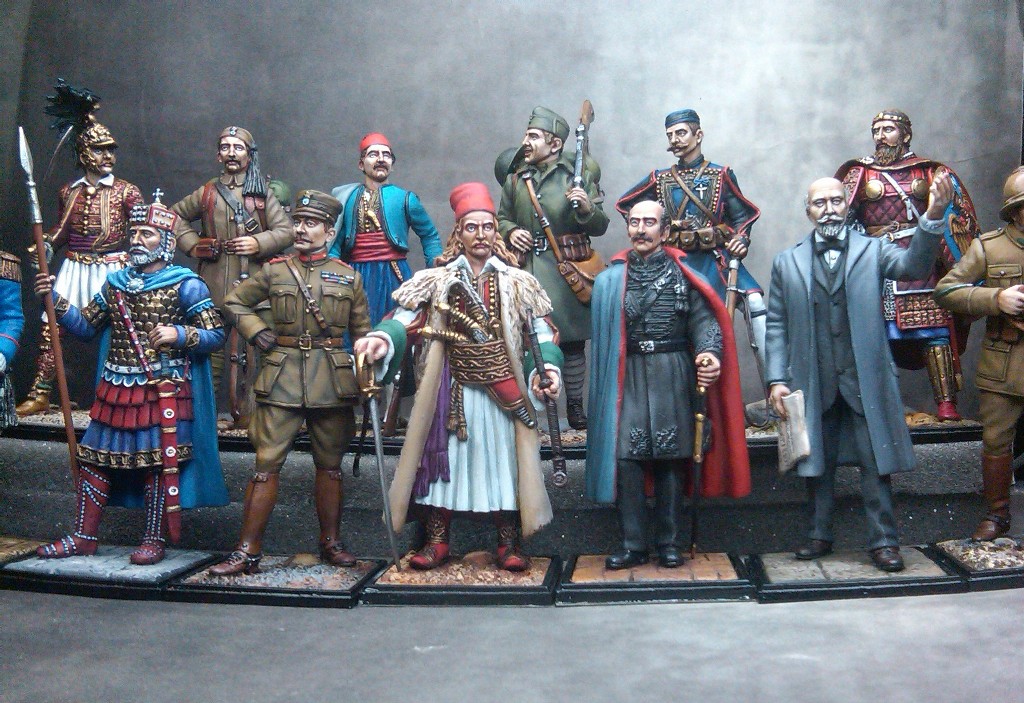
Figures from Greek ... and World Ηistory . With historical accuracy and great details in costumes and weapons.
Miniatures made of white metal to 54 mm (actually 60mm ).
Φιγούρες με θέματα από την Ελληνική και παγκόσμια Ιστορία. Με ιστορική ακρίβεια και μοναδικές λεπτομέρειες στις ενδυμασίες
και τα όπλα. Μινιατούρες φτιαγμένες από λευκό μέταλλο στα 54 mm ( πραγματικά 60mm ).
GREEK HEROES
figures
thank you for
browsing the site.
Greco - Italian war 1940 ,
WWII, On the albanian front , (Code 5950)
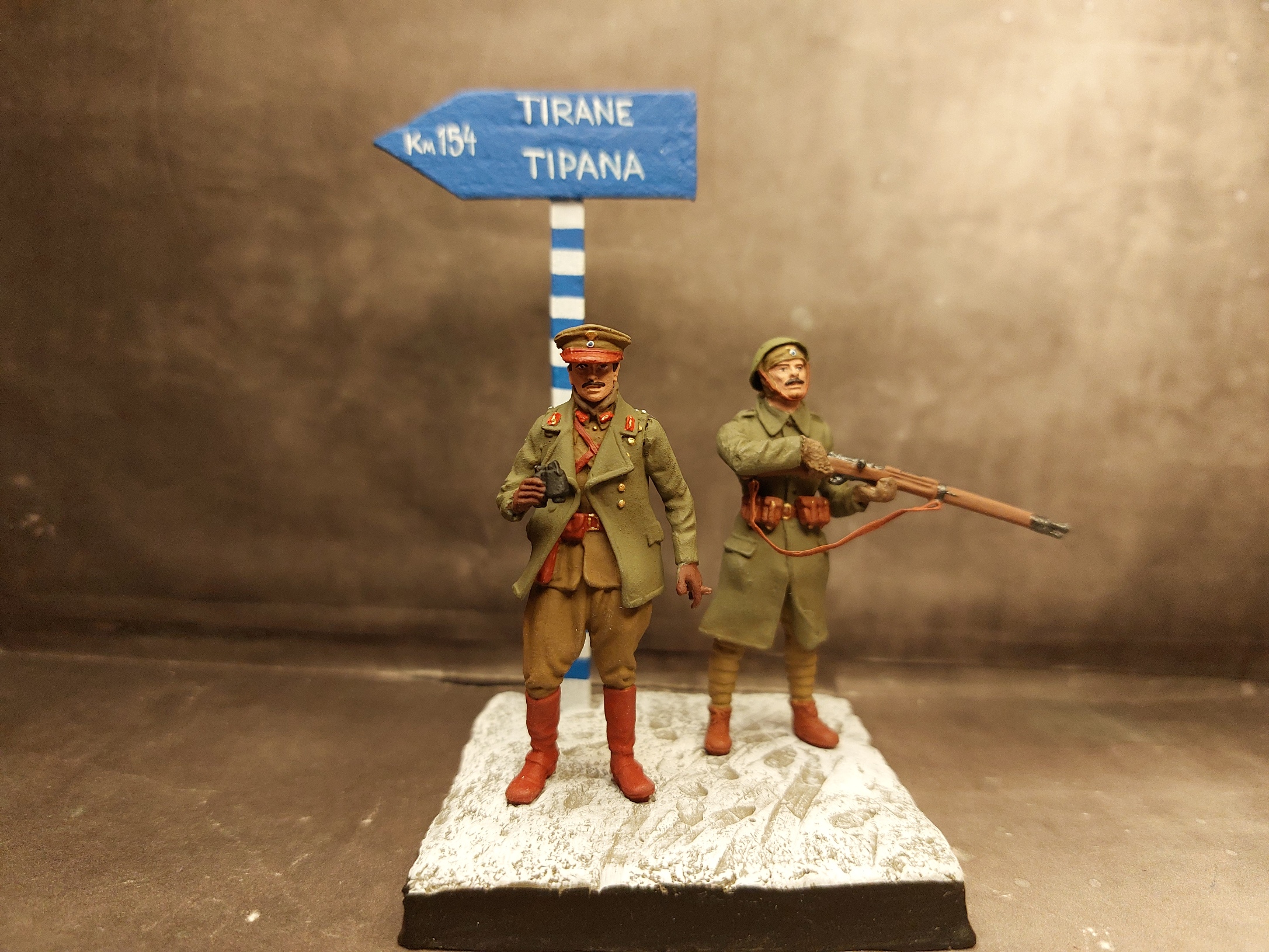


Greek Light Infantry , Private 2nd
Regiment 1812 English Army (code 5655)






Greek War of Independence 1821 - The three Angels of
Apocalypse - Nikitaras ( code 5740 ), Kolokotronis ( code
5700 ), Karaiskakis ( code 5741 )

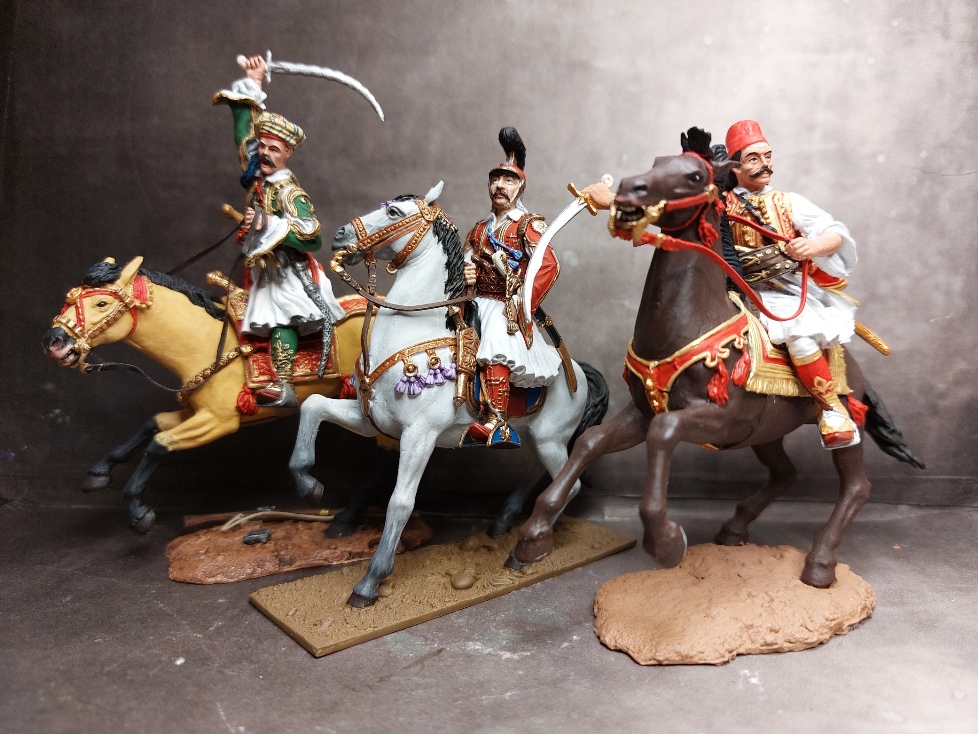

Souliotis nightfighter ( nyhtomahos), Greek War of
Independence 1821, Battle of Karpenisi 1823, ( code 5756
)



A greek battalion of evzones enters the city of
Thessaloniki ( October 26, 1912 ) during the first Balkan War
.




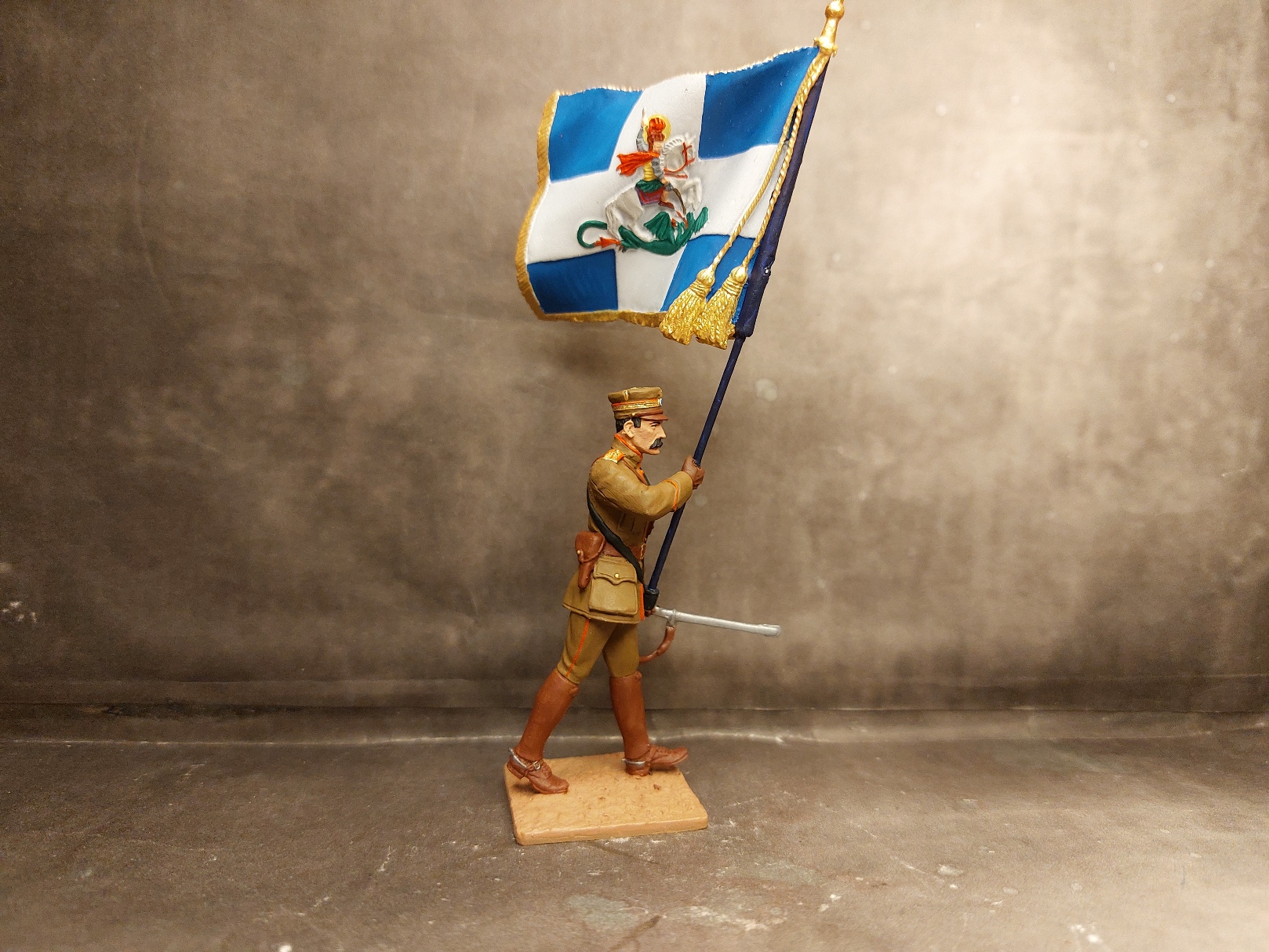
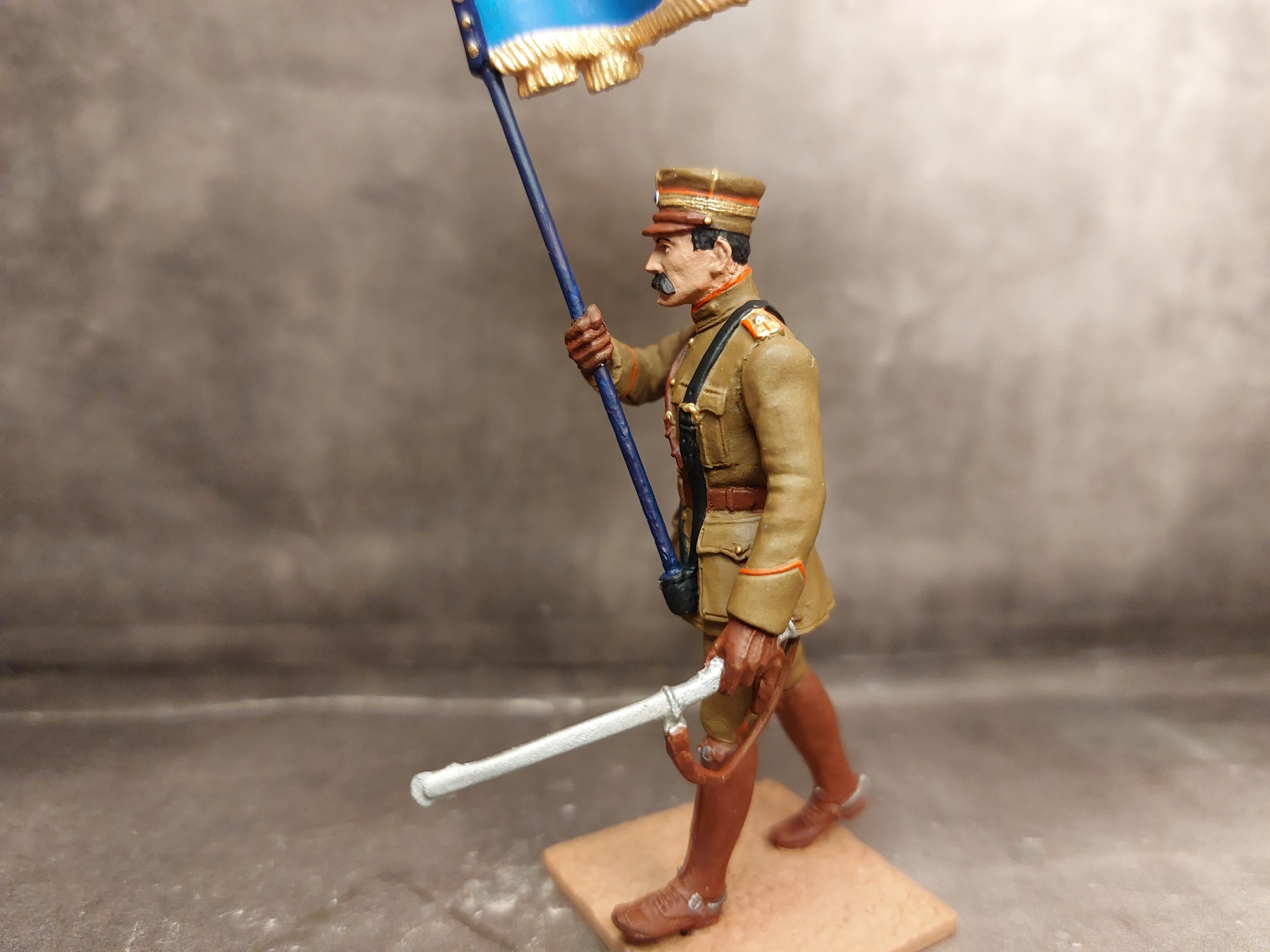
The Greek landing at Smyrna was a military operation by Greek forces starting on May 15, 1919 which involved landing troops in the city of Smyrna.



Staikos Staikopoulos (1799–1835) was a hero of
Greek Revolution 1821 (code 5755)



Staikos Staikopoulos (1799–1835) was born at Zatouna, Gortynia,
in Arcadia and from an early age was involved in the fur trade. On
the island of Hydra, where he went in 1818, he was recruited to the
Filiki Eteria by Nikolaos Speliotopoulos.
In 1821, upon the outbreak of the war, he raised his own company of
troops and departed Hydra for Argos. He began at once a siege of
Nafplio and quickly turned one of its commanders to his side. At
last on 29 November 1822, along with Demetrios Moschonesios, he
took the fortress of Palamidi, the feat for which he is best
remembered in the history books. Afterwards he was promoted from
chiliarch to strategos (general). Following this he laid siege to
the fort of Corinth, which fell under his occupation. He was the
first to face Ibrahim Pasha, from whom he took thirty prisoners,
who were sent to Nafplio. He had a seat in the Second National
Assembly at Astros. By leave of King Othon he remained in the army,
although under guard, since he was opposed to the king's
government.
He died on 21 February 1835, the day of his release from prison, in
the guardhouse of Leonardou in Nafplio, from the wounds and
hardships of war, and was buried in the old city
cemetery.
Mithridates VI Eupator (135 B.C. - 63 B.C.) King of
Pontus
Resin kit in 75mm and in 120mm by RP
Models
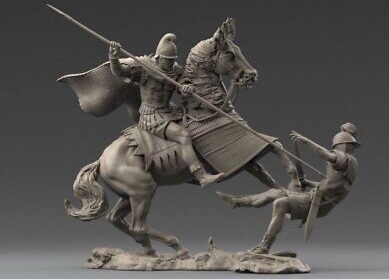
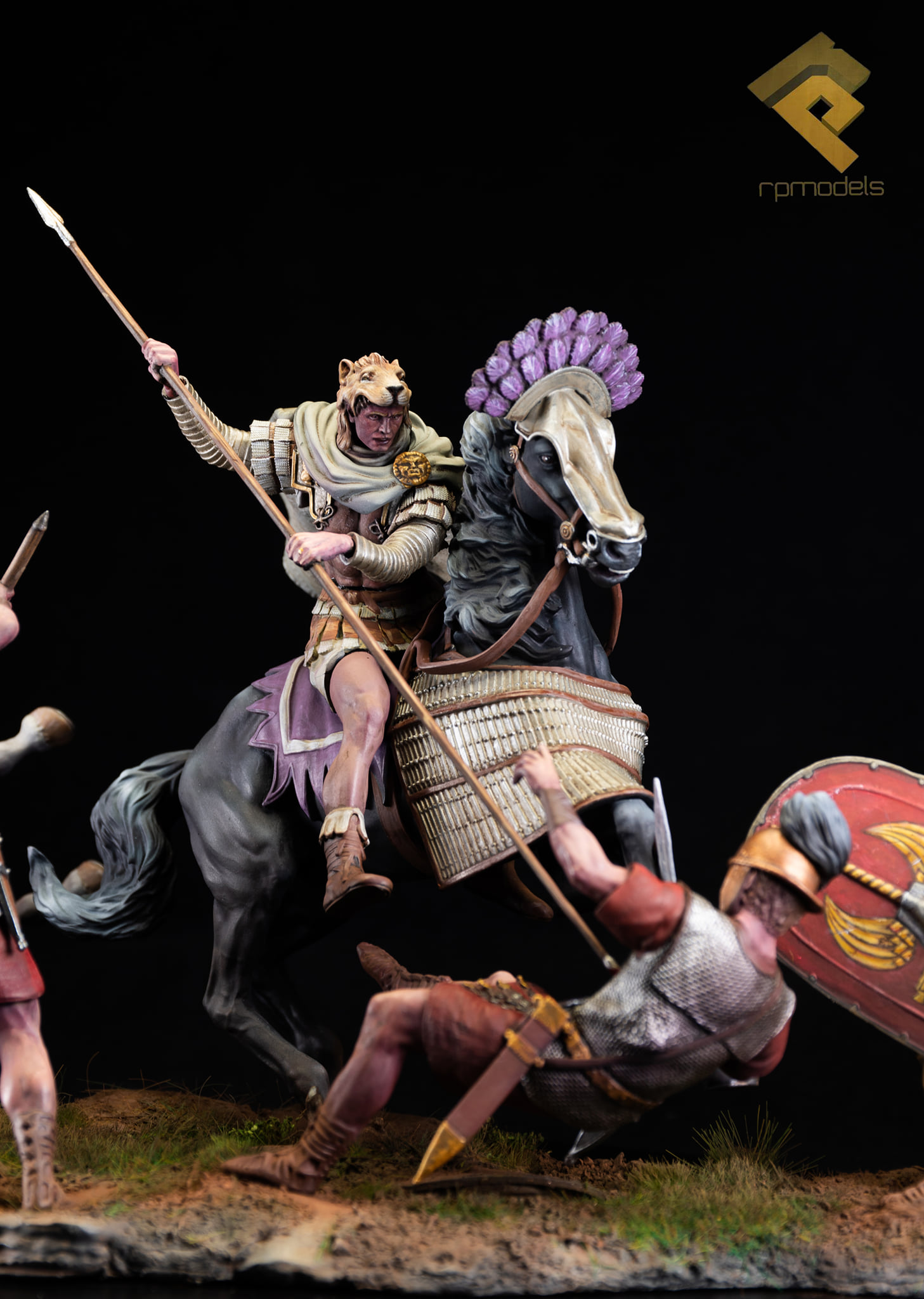

Alexander The Great , 75mm resin by the company Medieval Forge Miniatures
Box Art by Marc Musat
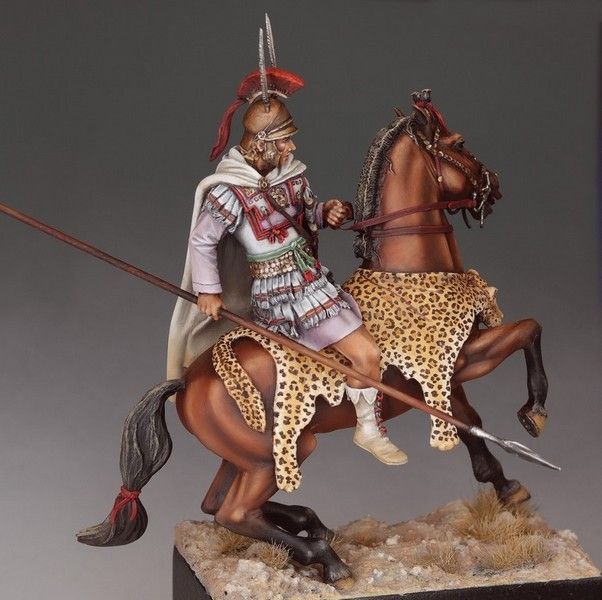


Sons of Poseidon . Resin figure at 75mm with the front
part of ship by Arts Soldier Company
A figure of ancient Greek in a sea battle, probably
Battle of Salamis



Kolokotromis at the battle of Dervenakia ,
July 22, 1822 code 5760
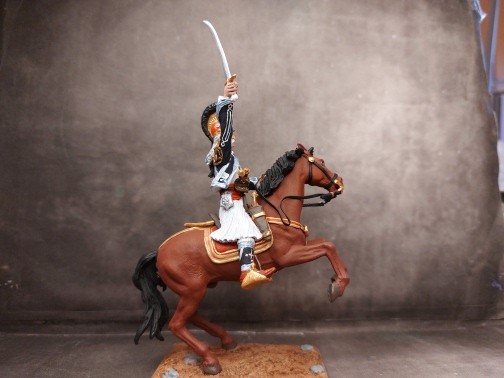

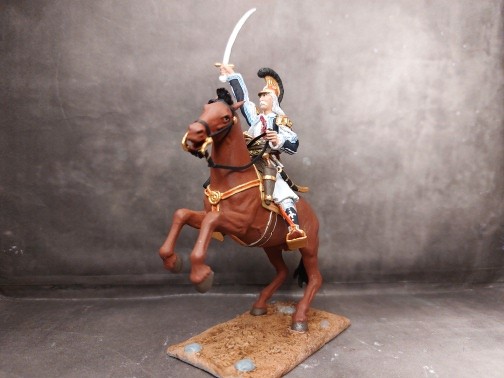
Constantine XI Palaiologos . Last Byzantine Emperor and Giovanni Giustiniani Longo
Two very beautiful figures at 54mm and also in
75 mm , resin kit and 3d print by Tartar company
3d sculpt Gor Gurochkin , box art Kiril Kanaev



Giovanni Giustiniani Longo (1418 - 1453) was a Genoese noble man, captain and defender of Constantinople during its siege in 1453.
He was born in the greek island of Chios.
Far right is a beautiful painting by Ioannis
Papoulakos of the two last defenders of Poli ( Constantinople
) Emperor Palaiologos and Giustiniani



Alexander the Great crossing the Granicus
river .
Granicus River battle 334 B.C. A very nice and very rare figure of King Alexander the Great by the Time Machine Miniatures company.
Figure was sculpted by Rendall Patton .
Metal 54mm

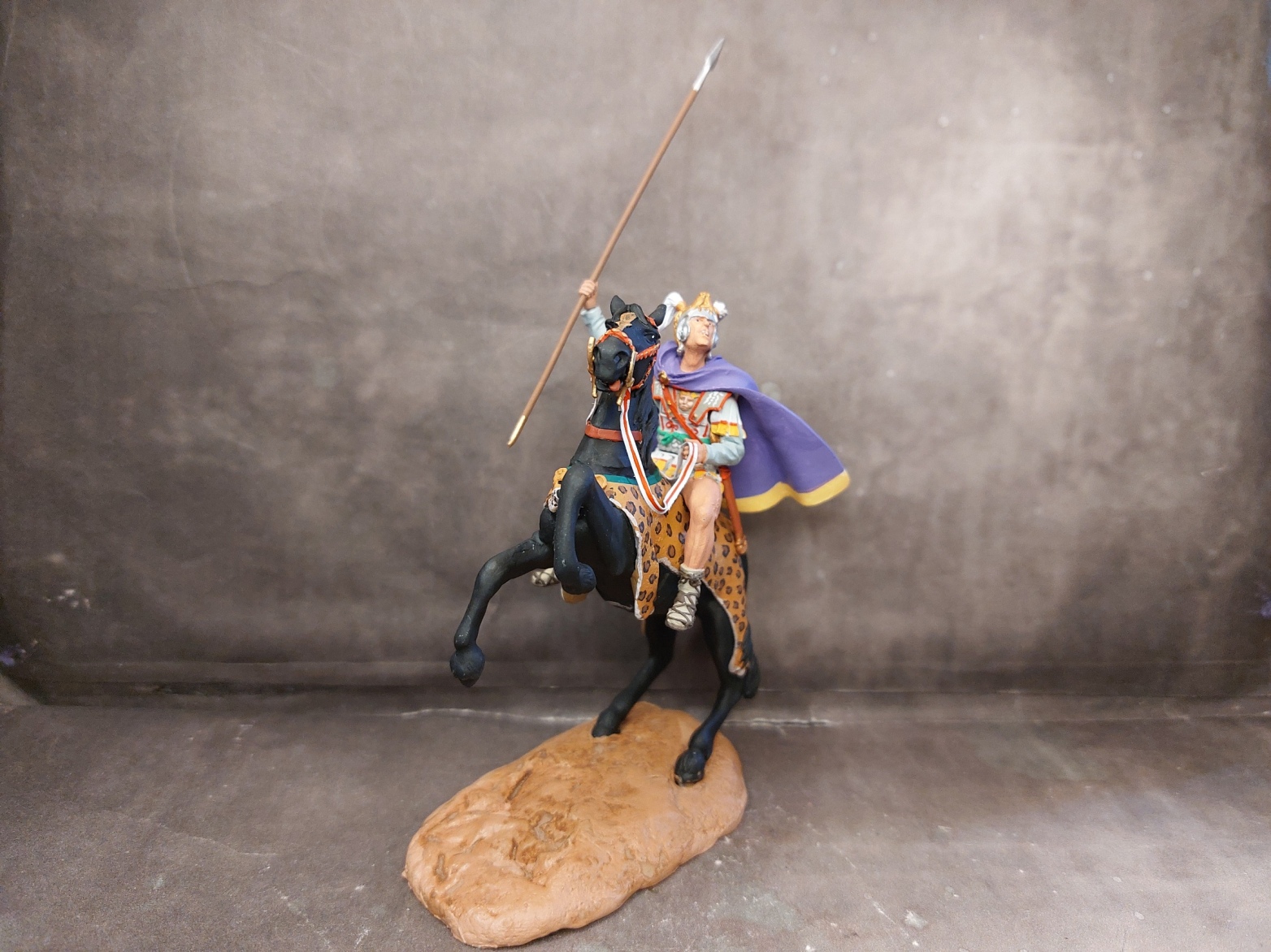

Maniatis (code 5754 )
Inspires from a woodcut of Henri Belle, Collection N. Grigoraki.
Henri Belle was a Frenchman who made three journeys to Greece. His
account of his travels was first published in instalments in the
magazine Le Tour du Monde and later in his
book Trois annees en Grece .



Greek Presidential Guard Pontian Uniform
(code 5991 )


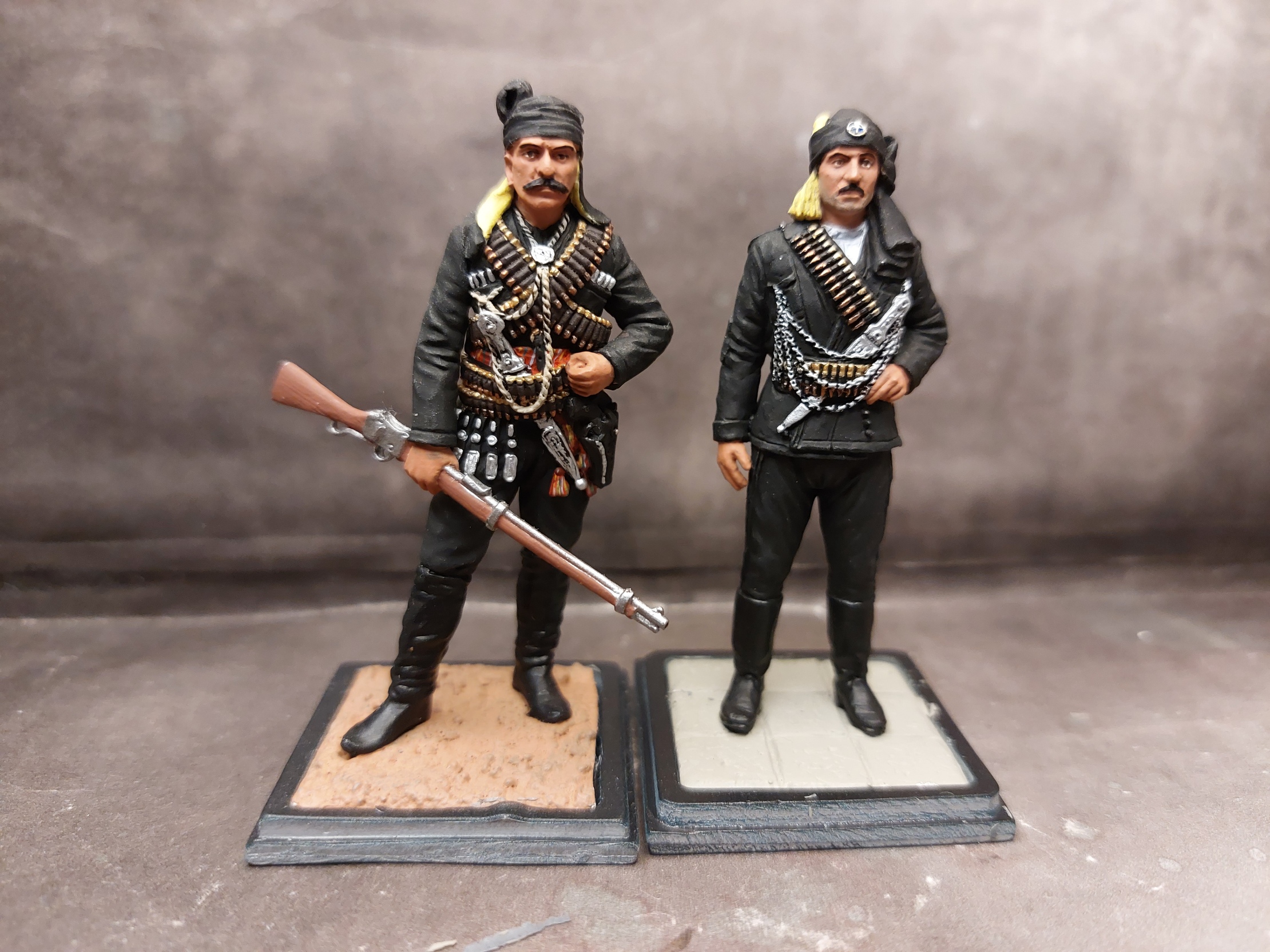
Greek War of Independence 1821 Greek Fighter (
code 5736 )



Greek Evzone Bugler 1912 - Balkan Wars ( code
5922)



Greek Cadet , Battle of Crete 1941- Operation Mercury (code 6939)



Greek Cadet with kepi , Battle of Crete 1941 (code
6941 )



Evzone Battle of Bizani -
Balkan Wars 1912 ( code 5934)



Andreas LONDOS, Greek military leader Greek War of Independence (code 5729)

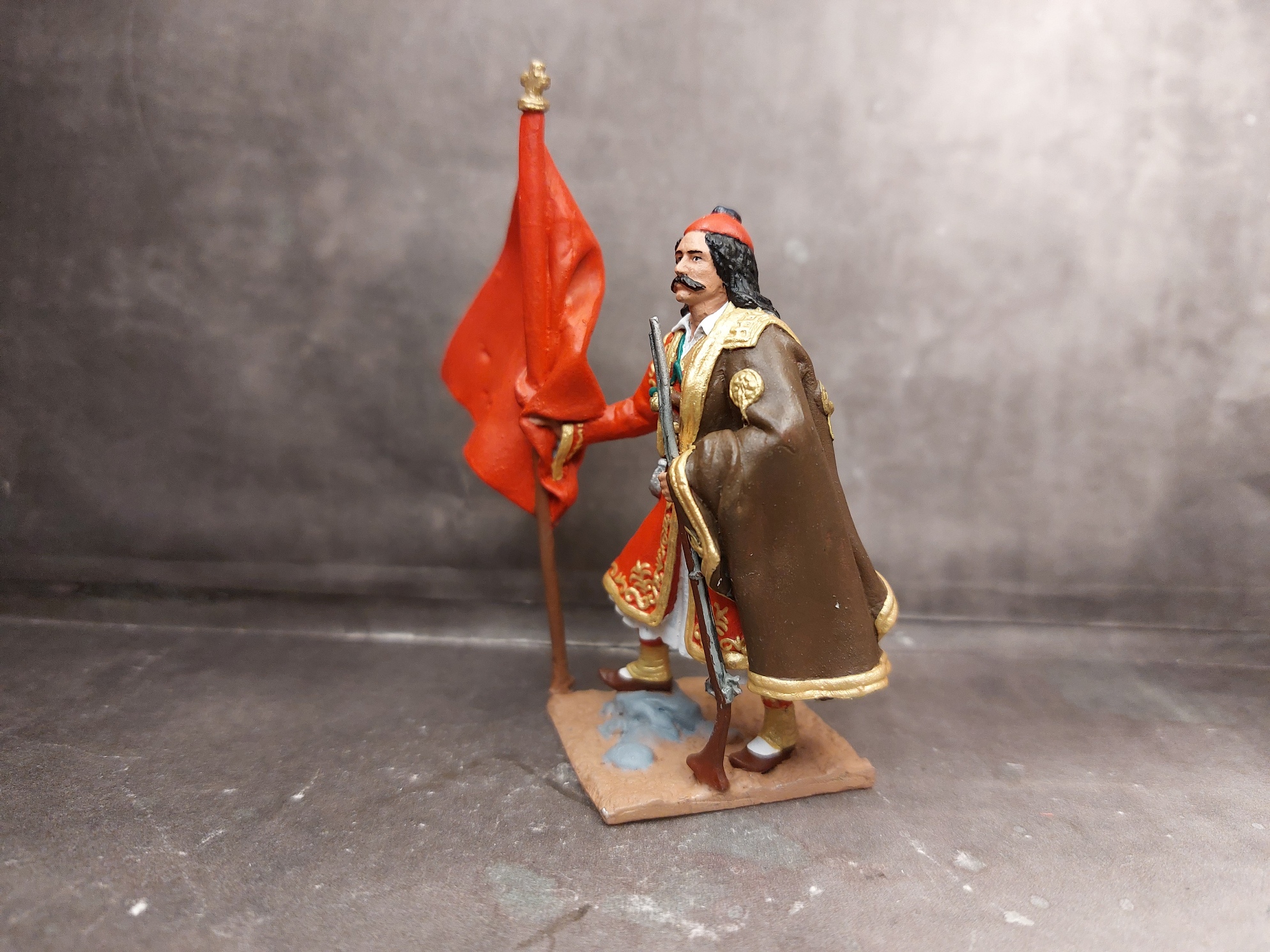

Andreas S. Londos (1786–1846) was a Greek military leader and politician. Born in Aigio (Vostitsa) in 1786, he was initiated into the Filiki Etaire;ia in 1818, and was one of the first military leaders to raise the banner of revolt in the Peloponnese during the Greek War of Independence.
On 26 January 1821, met Papaflessas at the Monastery of Archangels Michael and Gabriel in Aigio (Vostitsa) to discuss plans for an uprising against the Turks. At first, skeptical of Papaflessas's rhetoric for general uprising, Londos and the other leaders eventually raised the banner of independence on 10 March 1821, at the Monastery of Agia Lavra . On 23 March 1821, he and 400 Greek fighters marched on Aigio. Hearing rumours of a general insurrection, the Turks fled across the Gulf of Corinth and took refuge at Amfissa . The Greeks captured the town without a fight. Leaving 200 men as a garrison, Londos then marched on Patras to join the siege of the city's fortress.
In July 1822, at Akrata , a force of Greek fighters under Londos, Zaimis and Petimezas surrounded and attacked a group of 4,000 Turks marching to Patras after their defeat at theBattle of Dervenakia . Following Greek independence, he became involved in the September 3 Movenment that finally secured a constitution for the people of Greece . Andreas Londos died in 1846 in Athens.
Markos Botsaris
at battle of Karpenisi August 9 , 1823. Death of Markos
Botsaris. (code
5734)
Details from the
mural paintings with scenes from Greek War of Independence (1821 -
1929 ) in the Parliament in Athens ,Greece, originally Rooms
of Trophies & Adjutants of the Royal Palace. Made in 1836 by
the Ludwig Michael von Schwanthaler with help of Filippos and
Georgios Margaritis,



At midnight of August 8 1823 , Markos Botsaris assaulted the Ottoman camp at Kefalovriso near Karpenisi, believing surprise would secure their victory over Mustafa's larger army. Botsaris' men, even though they were eventually not supported by the majority of the Greek revolutionaries, managed to cause panic in the Ottoman camp, and inflicted severe casualties. Botsaris himself was wounded in his abdomen, but he continued on guiding his forces. Later, Botsaris raised his head above a walled enclosure in which many of his enemies were fortified, but he was shot dead. His men hid his death and continued the battle until dawn. The revolutionaries eventually retreated without stopping Mustafa Pasha’s expedition, but they looted nearly 700 pistols, 1,000 muskets and a large amount of horses, mules, and sheep. The army of Mustafa had lost 1,000 men while the Greeks had minimal casualties.
Botsaris’s corpse was transferred to Missolonghi, where he was buried with great honors. After the battle of Karpenisi, the Ottoman Albanian forces moved against Missolonghi and besieged it. However, they were finally defeated, and Mustafa Pasha retreated to Albania during December of 1823.
Greek offcer with sword on shoulder 1919 ( code 5947.2)



Nikos Mitropoulos
hoists the flag at Salona (Amfissa). Painting
of the capture of the city by the Greeks in 1821, by Louis
Dupré. (code
5761)



Georgios
Karaiskakis at the battle of Faliro April 22
1827 (
code 5741)


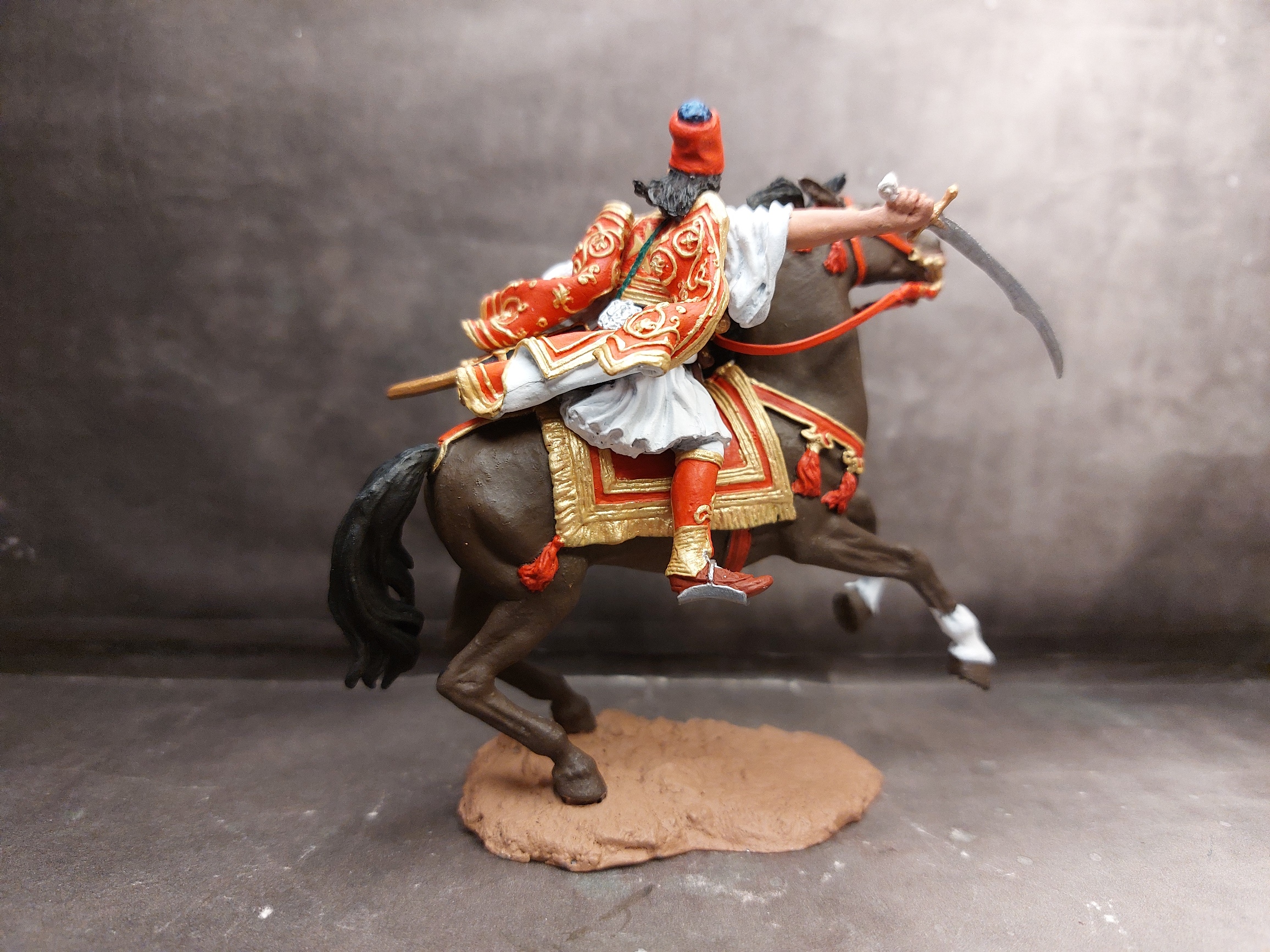
Nikitaras
on horse back Greek Revolution 1821
( code 5740
)



Chiftain
Panourgias PANOURGIAS - GreeK War of Independence
1821 (
code 5728 )

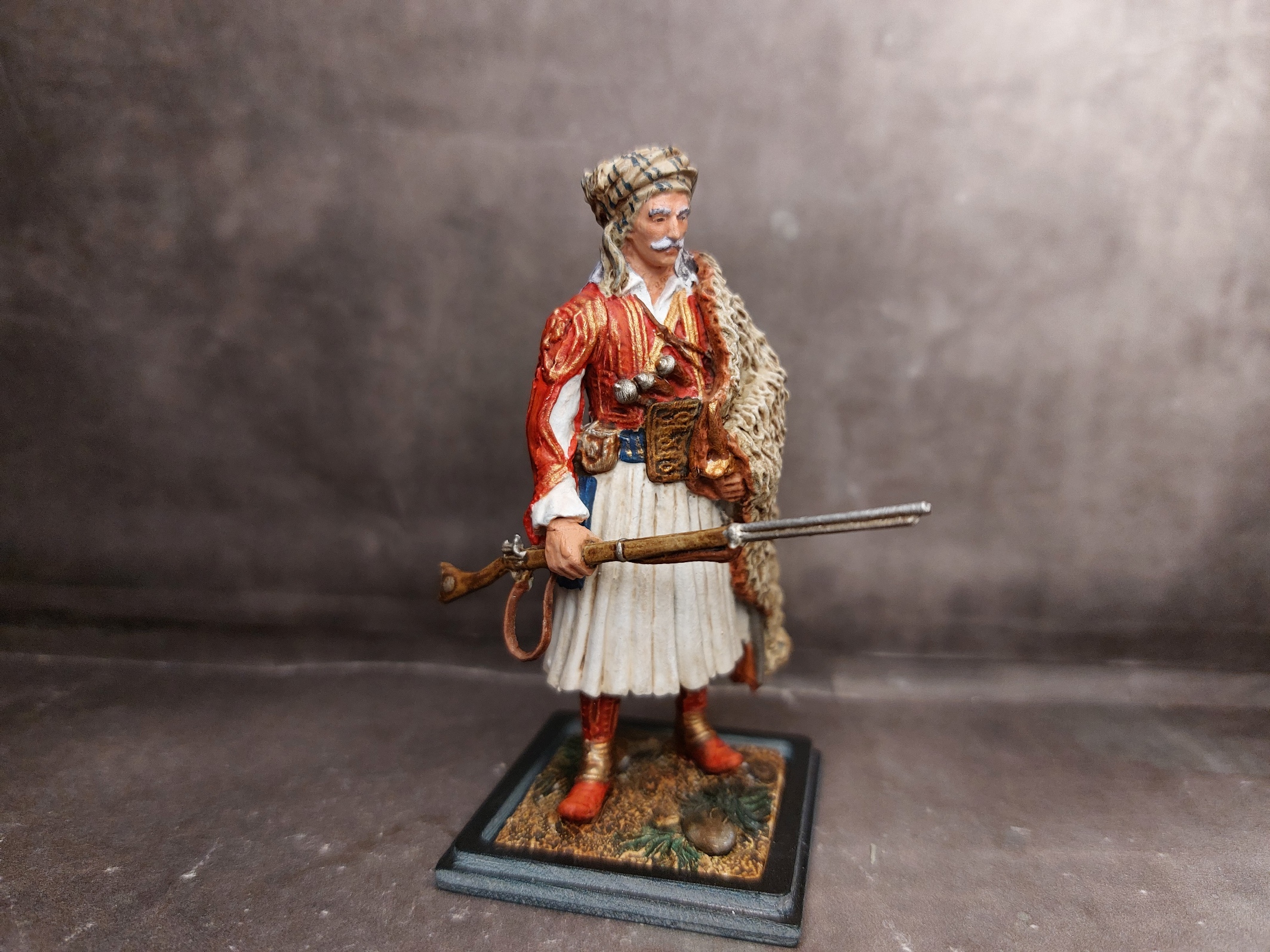

Panourgias Panourgias (1754-1834), a Greek
military commander during the Greek War of Independence, was born
in the village of Dremissa , Phokis. His parents originated from
the village Agios Georgios in Phocis, although he was born in
Dremissa. His family surname was Xiros (Ξηρός). The legend had that
his godfather, who baptised him, thought he was a boy and named him
with the female name "Panorea" (means very beautiful), and by that
name, in the masculine form, he was by then being called Panourias
. IIn early age took part in the Orlov revolt , against the
Ottomans, under Lambros Katsonis . In 1790 he entered the
armatoliki of Androutsos Verousis (father of Odysseas
Androutsos)
On 24 March 1821 he declared the Revolution in Amfissa (then Salona), forcing the surrender of the Ottoman garrison on 10 April.
He then collaborated with Athanassios Diakos and Dyovouniotis in order to halt Omer Vryonis from advancing further into Central Greece. Panourgias with his band was to defend the hills of Chalkomata, near Thermopylae, but was seriously wounded during the fights and had to withdraw.
He later was one of the defenders of the eponymous inn in the Battle at Gravia Inn, and fought in the Battle of Vassilika , the surrender of Corinth, the Battle of Ampliani , the Battle of Haidari, the Battle of Distomo, and other battles. He participated in January, 1822 to the First National Assembly at Epidaurusas representative of Amfissa. He died in 1834 at Amfissa.
Evzone
- Border Guard with cape , 2012 code
5998



The Evzone rifleman guarding the borders in the official Evzone uniform , blue doulamas, on very cold winter days, also wear a heavy woolen cape.
Under this cape Evzone is wearing the blue dpulamas of the Presidential Guard. Evzone with its blue collar and a belt with two small catridge cases.
He is also armed with a Greek , made in Germany , G3A3 NATO
rifle with bayonet.
Cretan
Evzone - Greek Royal Guard
1965 code
5990.1



The Cretan Evzone Unit was created in the post war (WWII) period in order to represent the Greek Islanders. The official uniform of the Cretan Evzones
was based on the local male dress of Crete island. On their belt hung a traditional Cretan knife, its sheath decorated in silver, with a handle made of white bone.
When they took in ceremonies or parades they carried a british Lee Enfield No 4 Mark I rifle withoout a bayonet.
Today, the Cretan Evzones of Greek Presidential Guard wear the
same uniform. When on duty they only carry the Cretan
kmife.
Greek War of Independence 1821
- Diorama

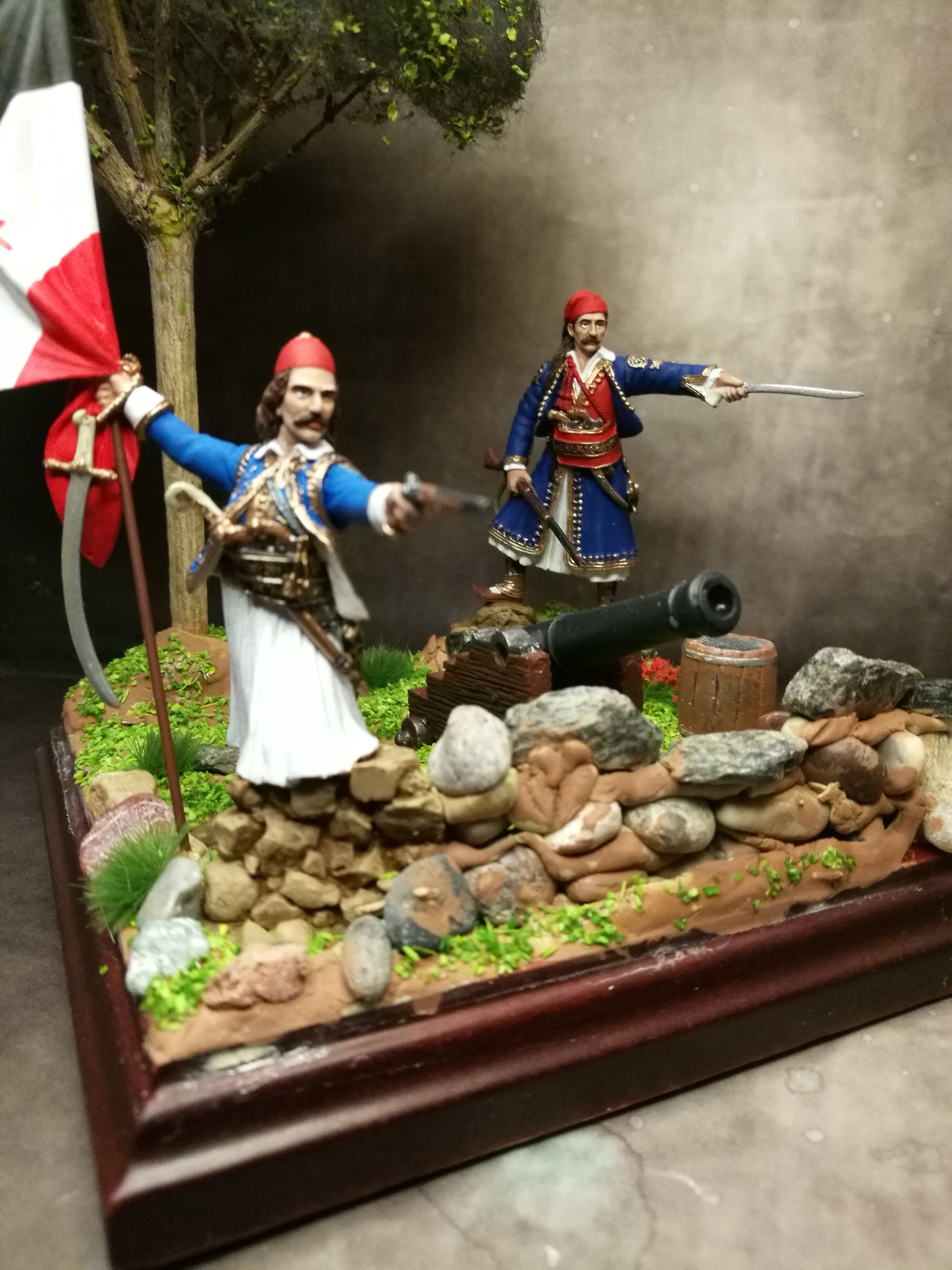

WWII Greek Army 1940
Diorama



EVZONES - Greek Army Balkan Wars 1912 - 1913 Diorama

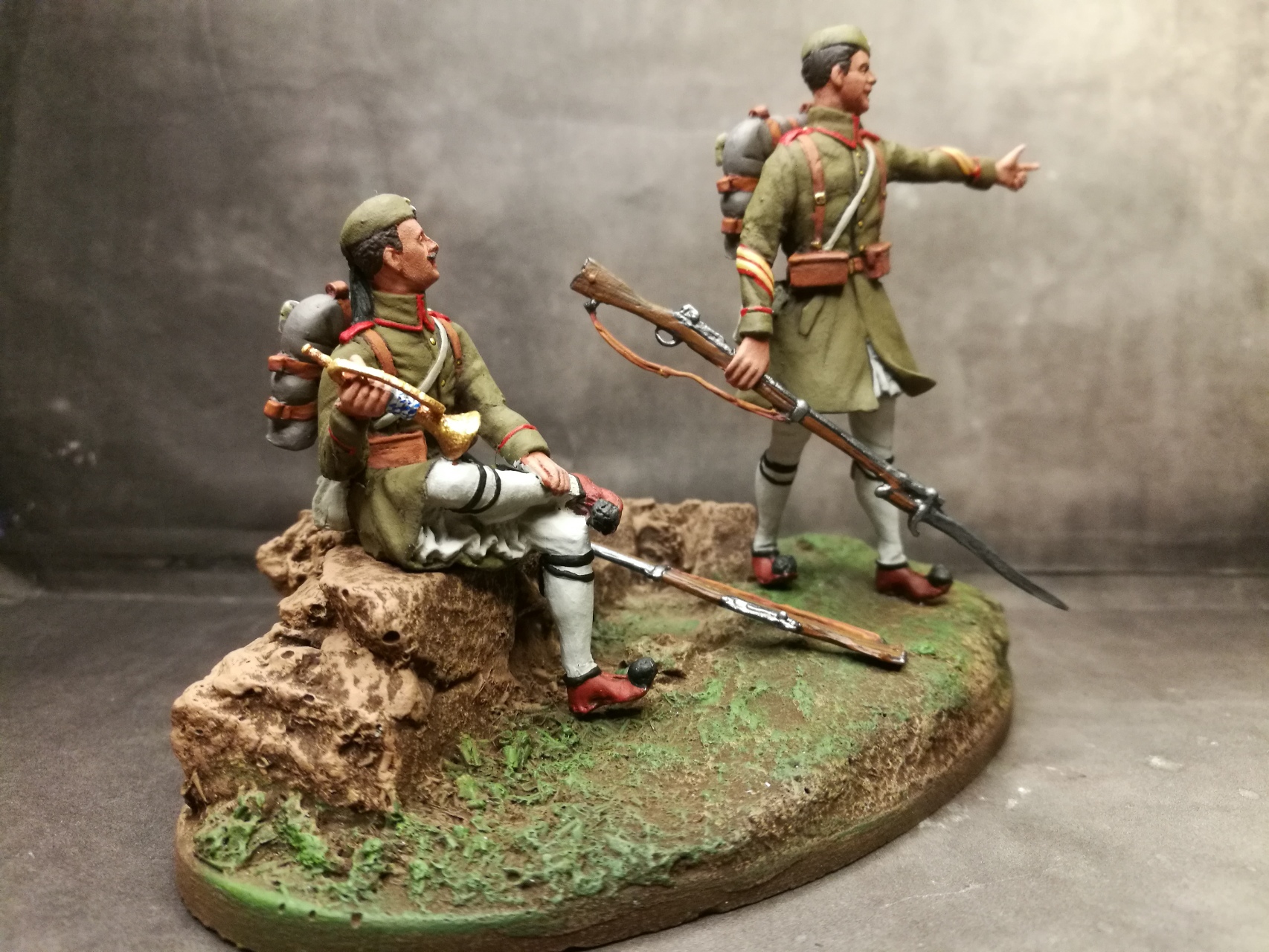
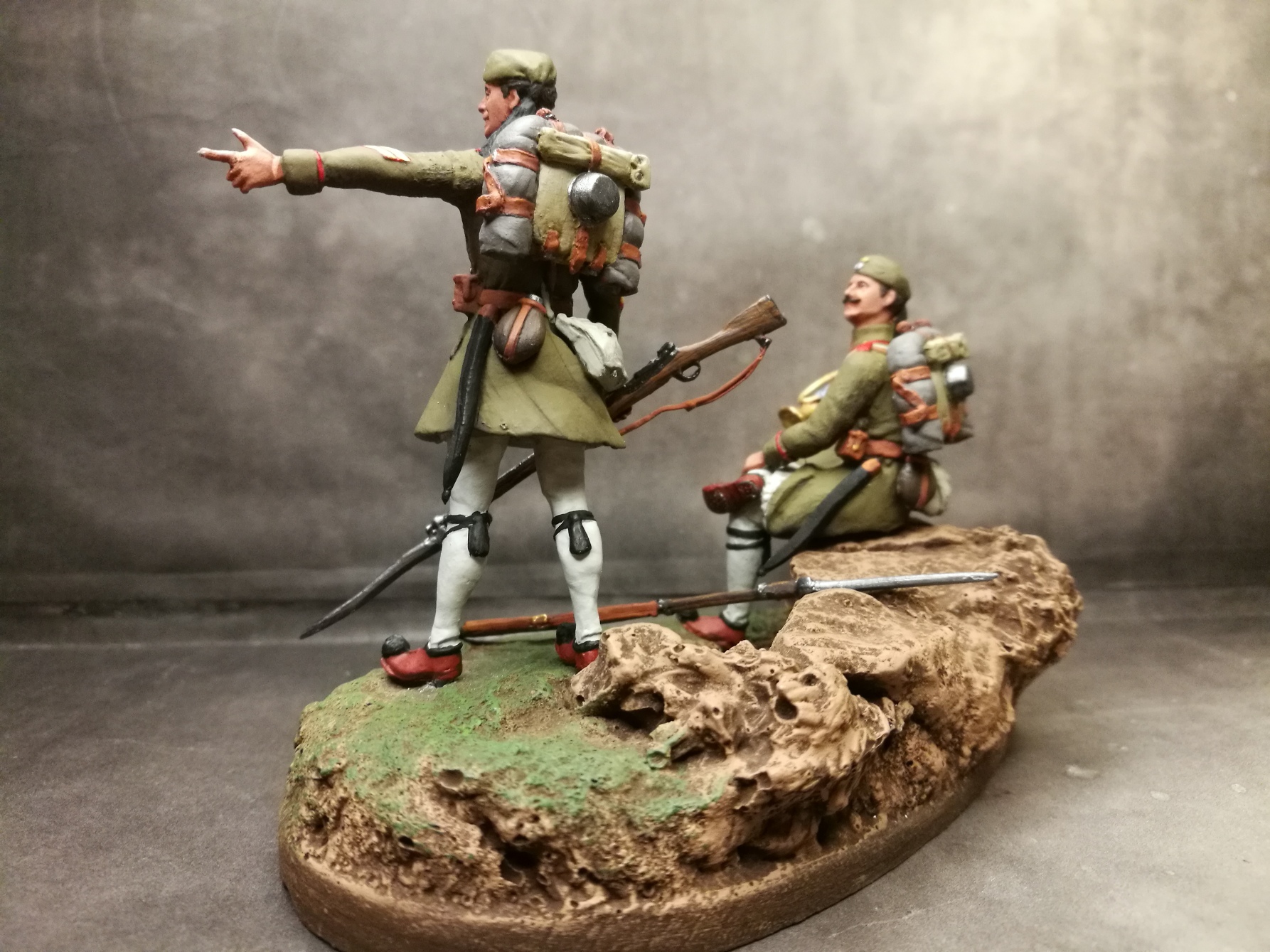



After WWII, a new Evzone uniform was designed for the officers in the Royal Guard, which they wore at inspections, parades and national celebrations.
On their farion , the officers wore the gilt embroidered historical emblem of the officers in the Greek Phalanx (1835). The emblem is a laurel branch in the
shape of an upturned heart, with the royal crown at its centre.
The blue tunic, which replaced the pre-war fermeli of the Evzone officers, was of a european type and had gold knitted epaulets with the rank insignia
of the No1 uniform of Greek Army officers. A special type of sword with a curved blade was carried by the officers.
This beautiful uniform was abolished in 1968.
Lambros KATSONIS holding his flag at the battle of Porto Kayo 1792) , ( code 5699 .2)



The meeting of the two generals - Theodoros Kolokotronis and Georgios Karaiskakis Greek War of Independence 1821



“ That's what we fought for. "
General Ioannis
Makriyiannis Greek War of Independence
1821



General Ioannis Makriyiannis wrote in his memoires
"I had two famous statues, a woman and a prince, intact - their veins were visible, they were so perfect. When they destroyed Poros, soldiers take them, and in Argos they would sell them to some Europeans, a thousand thalers would ask for.... I took the soldiers aside and told them: These, and ten thousand thalers to give you, do not accept to leave our homeland. That's what we fought for. "
“Είχα δύο αγάλματα περίφημα, μια γυναίκα κι ένα βασιλόπουλο, ατόφια – φαίνονταν οι φλέβες τους, τόσην εντέλειαν είχαν. Όταν χάλασαν τον Πόρο, τα ‘χαν πάρει κάτι στρατιώτες, και στ’ Άργος θα τα πουλούσαν κάτι Ευρωπαίων, χίλια τάλαρα γύρευαν… Πήρα τους στρατιώτες και τους μίλησα: Αυτά, και δέκα χιλιάδες τάλαρα να σας δώσουν, μην καταδεχτείτε να βγούν από την πατρίδα μας. Γι’ αυτά πολεμήσαμε”.
Greek Military Units in the WWI Victory Parade in Arc of Triumph,
Paris, July 14, 1919


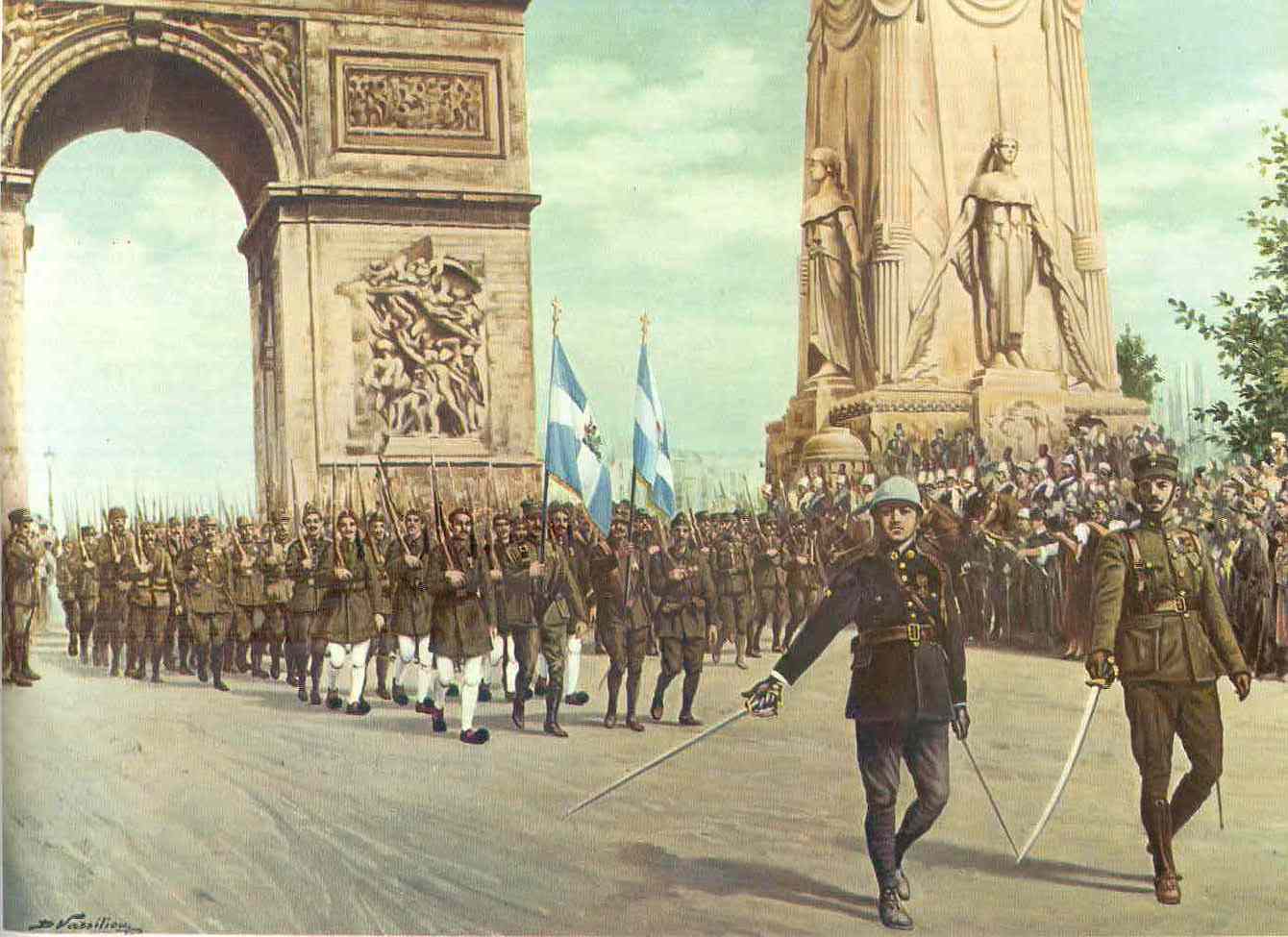
Greek
Soldiers in Paris, July 14, 1919 , Celebration of the end of
WWI
London , Greek troops passing Buckingham Palce, King Georgr
V
(Photo
personal collection Regine Verguier
)
taking the salute , July 19, 1919


Greek Officer marching Paris 1919 (code 5947.1 )



Greek
Officer Standard Bearer marching 1919
(code 5948.1 )



Greek
Soldier with side cup marching 1919, (
code 5937. 4 )
Greek evzone marching 1919 ( code 5949
)


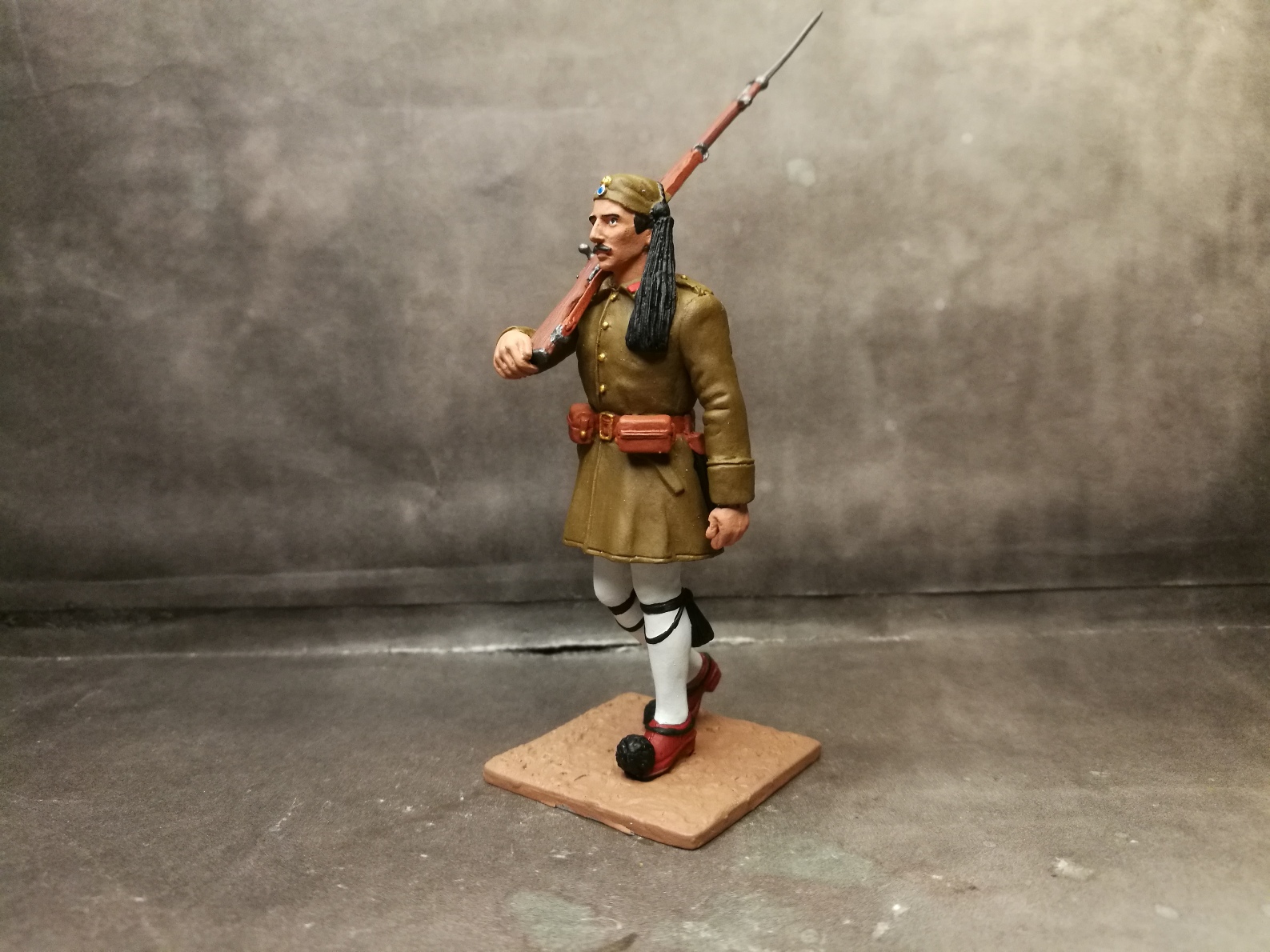
Greek Private, WWI, 1917 ( code 5937.6 )



Greek corporal, 6th Infantry Regiment, 1912 (code
5937.1)






The regiment was formed in 1877 in Arta. It fought in the Epirus front of the Greco-Turkish War of 1897. During the First Balkan War of 1912–13 it took part in the battles of Sarantaporo, Giannitsa and the operations in western Macedonia and Northern Epirus, advancing as far as Kleisoura. The regiment also fought in the Battle of Kilkis-Lahanas and the other operations of the Second Balkan War (1913). In 1918 it fought in the Macedonian front of World War I under French command, while in 1920 it took part in the operations in Eastern Thrace, before being transferred to the front in Asia Minor, where it remained until the Greek retreat in 1922. During the Greco-Italian War of 1940–41, the regiment captured Argyrokastro and Himarra. It was disbanded after the German invasion of Greece and the surrender of the Greek Army in April 1941.
After the end of World War II, on 16 March 1946 a training centre for new recruits was established at Corinth, which on 20 September 1965 received the designation "6th Infantry Regiment". On 23 November 2000, the regiment received the honorific name "Himarra". For its wartime service, the regiment had been twice decorated with the highest Greek military distinction, the Commander's Cross of the Cross of Valour, the first time on 19 June 1921 for the Asia Minor Campaign, and the second on 28 May 1941 for the Greco-Italian War. The regiment and the training centre were disbanded in February 2013.
Greek Garibaldino , Battle at Driskos 1912
(code 5937.2)






The Italian Garibaldini Volunteer Corps was founded in 1862
by the Italian patriot and national hero Giuseppe Garibaldi, hence
its name. The basic principle of the Italian Garibaldini was their
joint coexistence with those who fought for the conquest of
freedom. Its members also bore the name "Erythrochitones" from the
red color of the tunic they wore.During the Greek-Turkish War
of 1897, Giuseppe Garibaldi's son, Ricciotti, rushed to the side of
the Greeks with 300 men, took part in the battle of Domokos 9
6-5-1897. The
Garibaldi uniform consisted of the red tunic with khaki
pants.
The Garibaldi Corps in 1912, led by brothers Ricciotti and Pipino Garibaldi, joined the Greek Garibaldini volunteers of Alexander Romas, Member of Parliament for Zakynthos island and former Speaker of Parliament, in the struggle for the liberation of Epirus and Western Macedonia. Eight hundends Greek Garibaldini took part in the battle of Driskos (November 26, 1912). Their fate was predetermined. They may have lost a battle, but they won national gratitude and eternal glory.
Greek Infantry , Archipelagos Division 1920 (code
5937.3)

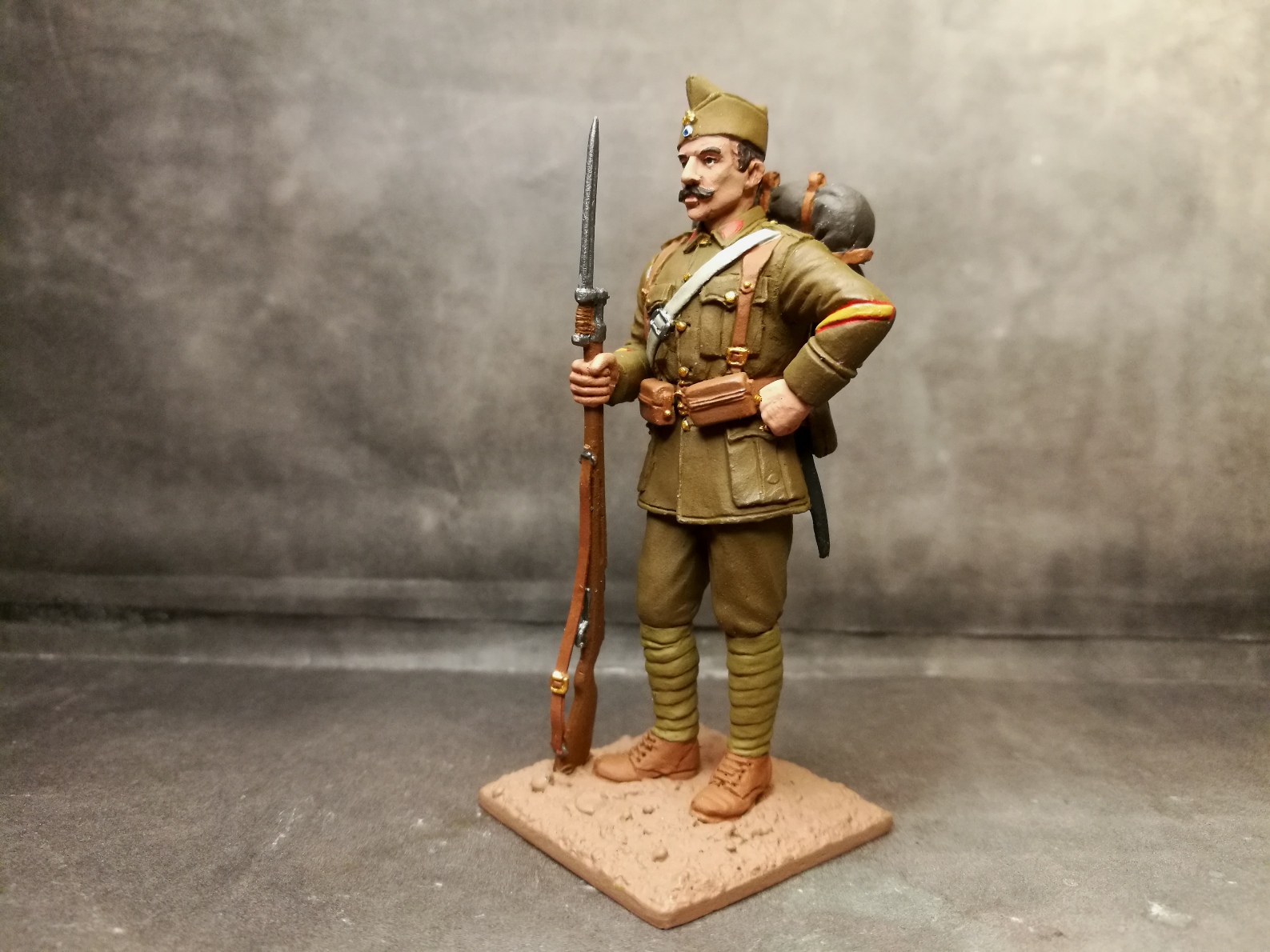




The Archipelagos Division (Μεραρχία Ἀρχιπελάγους) was an infantry division of Greece in World War I and the early stages of the Asia Minor Campaign.The division began being raised in September 1916 by the Provisional Government of National Defence, as part of its efforts to create its own army for service alongside the Allies on the Macedonian front.As its name signifies, the Archipelago Division was recruited in the Aegean islands, chiefly Chios, Lesbos, and Samos. After training was completed in March 1917, the division was ferried to Thessaloniki in April. On 20 October the division was moved east to the Polykastro–Goumenissa area, where it took over a front sector adjoining the Crete Division to its right. The Greek divisions came under the 1st Group of Divisions, under Auguste Clément Gérôme [fr], commander of the French 122nd Infantry Division [fr]. The division held this sector until May 1918, when it participated in the Battle of Skra-di-Legen. The Archipelago Division remained in eastern Macedonia until May 1919, when it was shipped to Asia Minor to take up occupation duties in the Smyrna Zone. On 12 December, as the Greek forces in Asia Minor were grouped into the Army of Asia Minor, the division became part of the newly constituted Smyrna Army Corps .
Following the victory of the royalist opposition in the 1920 Greek legislative election, and on 24 December the division was renamed from its "Venizelist" name to the 7th Infantry Division. In the photographe Allied commander-in-chief Louis Franchet d'Espérey decorates the battle flag of the 5th Archipelago Regiment in 1918, with the divisional commander Dimitrios Ioannou to his left




An amazing diorama " Battle of Dervenakia - 1821"
by Gregory
Marmatakis
GreeK Pontic Militia Fighter 1919 excellent
painting by Roger Newsome
Greek Light Infantry - Bugler 1838 ( code
5731,3 )




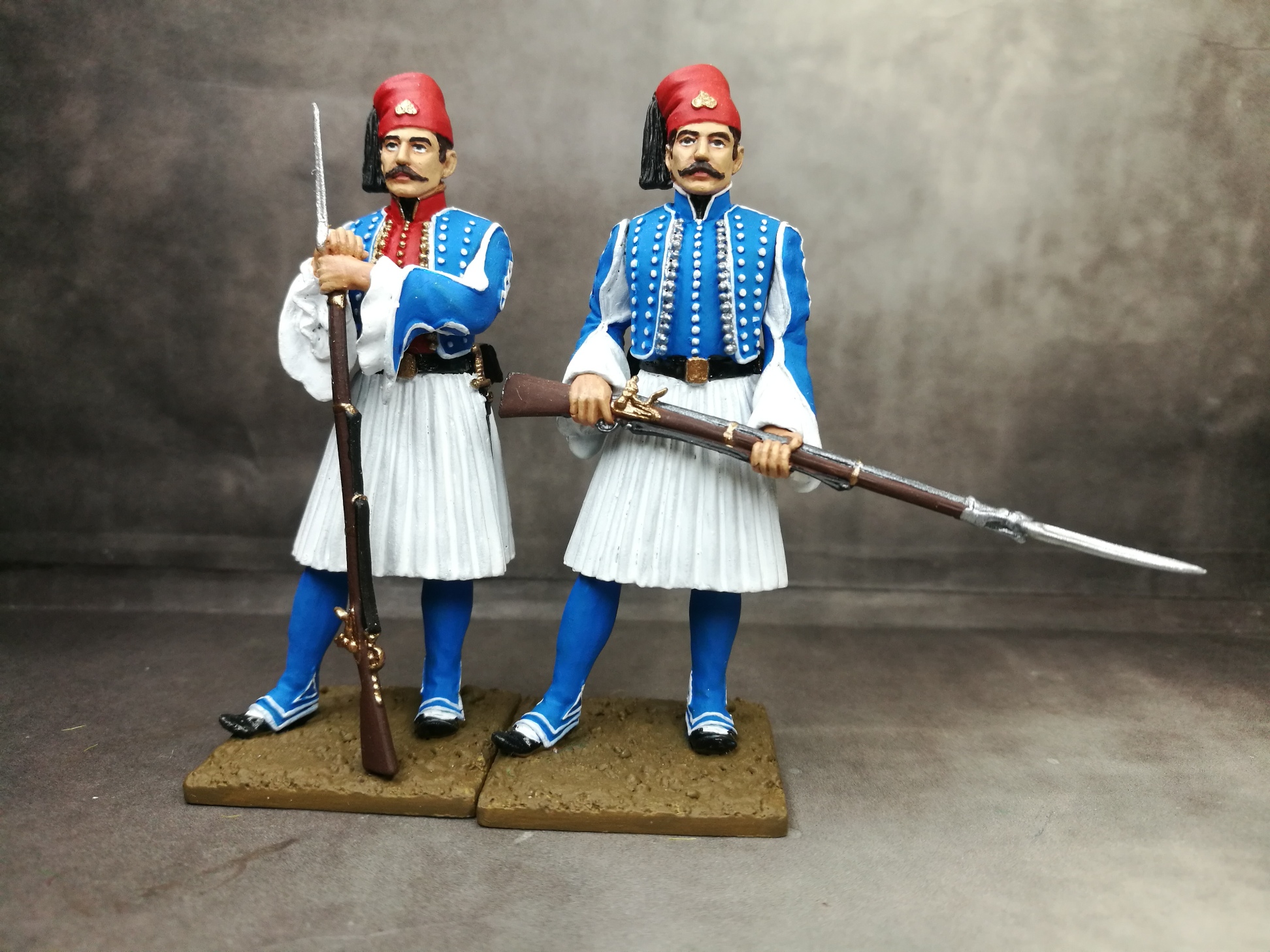

Greek Army,
Standard Bearer , 33rd Infantry Regiment,
1921 ( code 5920 )






Greek
Pontic militia fighter 1919
(code 5938 )
"
IN MEMORIA "
100 Years 1919 -
2019






Greek Pontic militia fighter
1919
Greek Officer
Standard Bearer - WWI 1917
Macedonian Front (code 5929,2 )


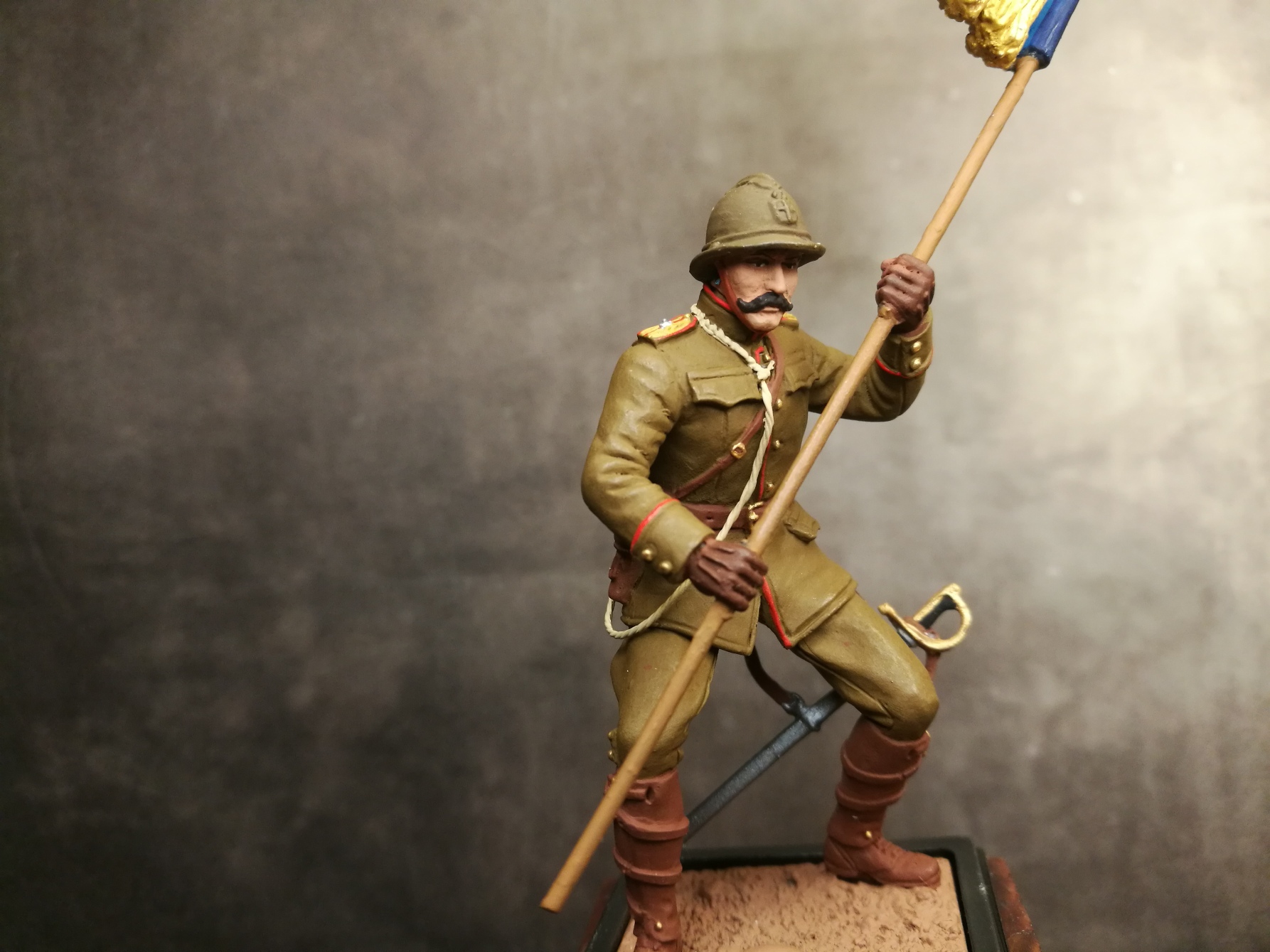
MOUNTAIN
GUARD 1838 - 1854 (
code 5780 )






MOUNTAI GUARD . Eight Mountain
Guaed battalions were formed by the Royal Decree of January 25,
1838. Mountain Guard's duty was to guard country's borders and to
maintain public order. Mountain Guards wore uniforms based on
the Greek national uniform. Their battalion number was swen at the
top of their fermeli sleeves, in blue woolen thread. Under their
red cloth belt (selachi) wore a leather belt on the back of which
hung two small brass cartidge belt. They had pistols of various
types, knives and yatagans tucked in their selachi. Along with
their traditional kariofilia rifles ( as it is in the
miniature), the Guards were also armed with european M1777 I
nfantry rifles.
The miniature is based on the watercolor of
L.Koelnberger , from that period of time.
EVZONE 2nd Battalion 1868 - 1888
(
code 5781 )
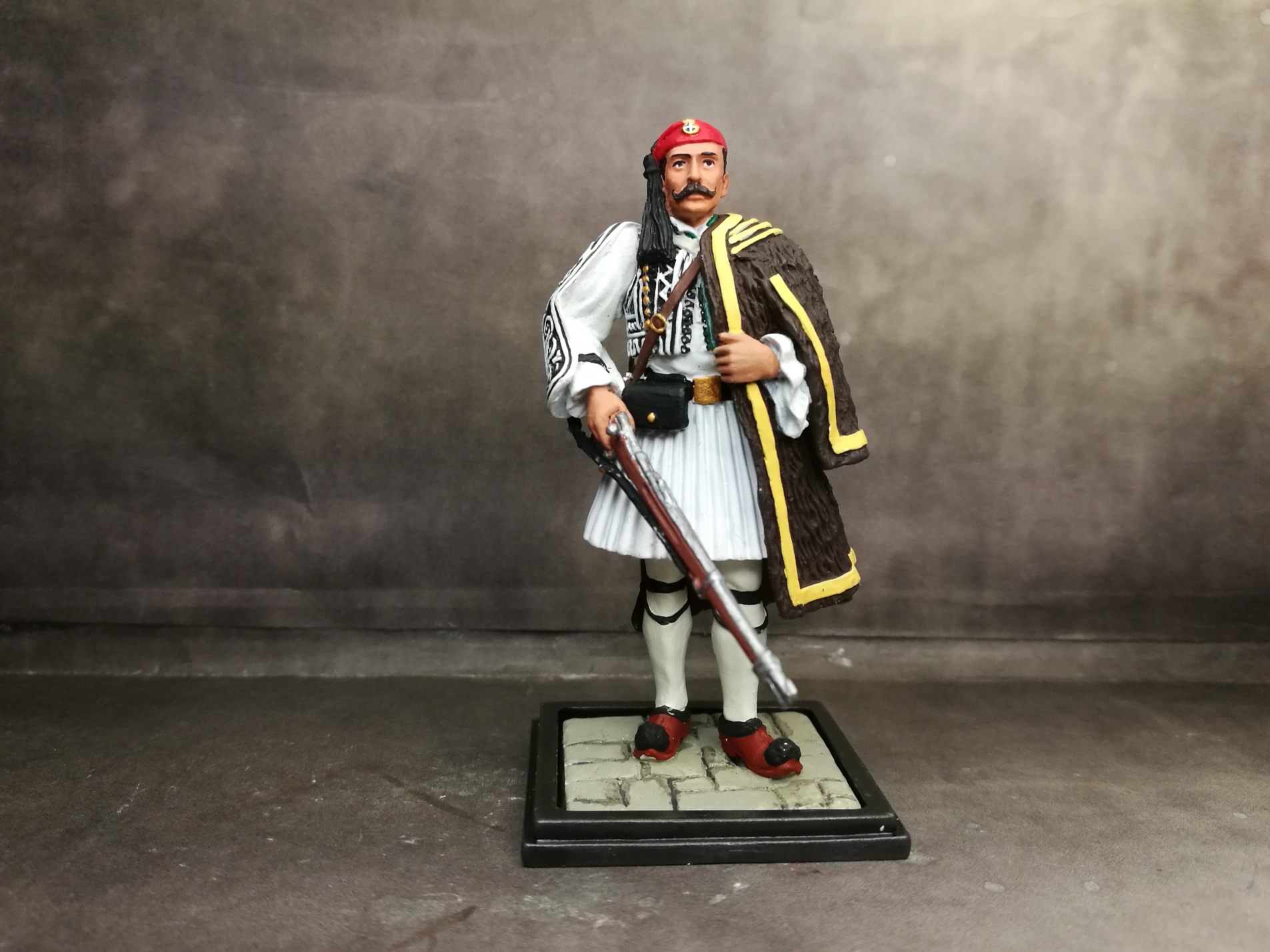





The Evzone of the 2nd Battalion differed due to his green collar. To protect himself from the icy cold he wore the characteristic heavyweight cape of the highlands herders, which was made of goats wool, He used french type M1845/68 Infantry accountrements.
The uniform shirt eas made of white cloth and had white sleeves, The white fustanella (skirt) had no more than 150 pleats and its length was down the knee. Evzone’s accoutrements were the same as those used used by the Infantry soldiers (French type, M1845/68, made of black leather).
Evzones carried a muzzle - loading French M1857 rifle with sword bayonet.

Lambros KATSONIS (1752–1804) ,
Greek Colonel and Knight of St. George Order ,
1790 ( code 5699)

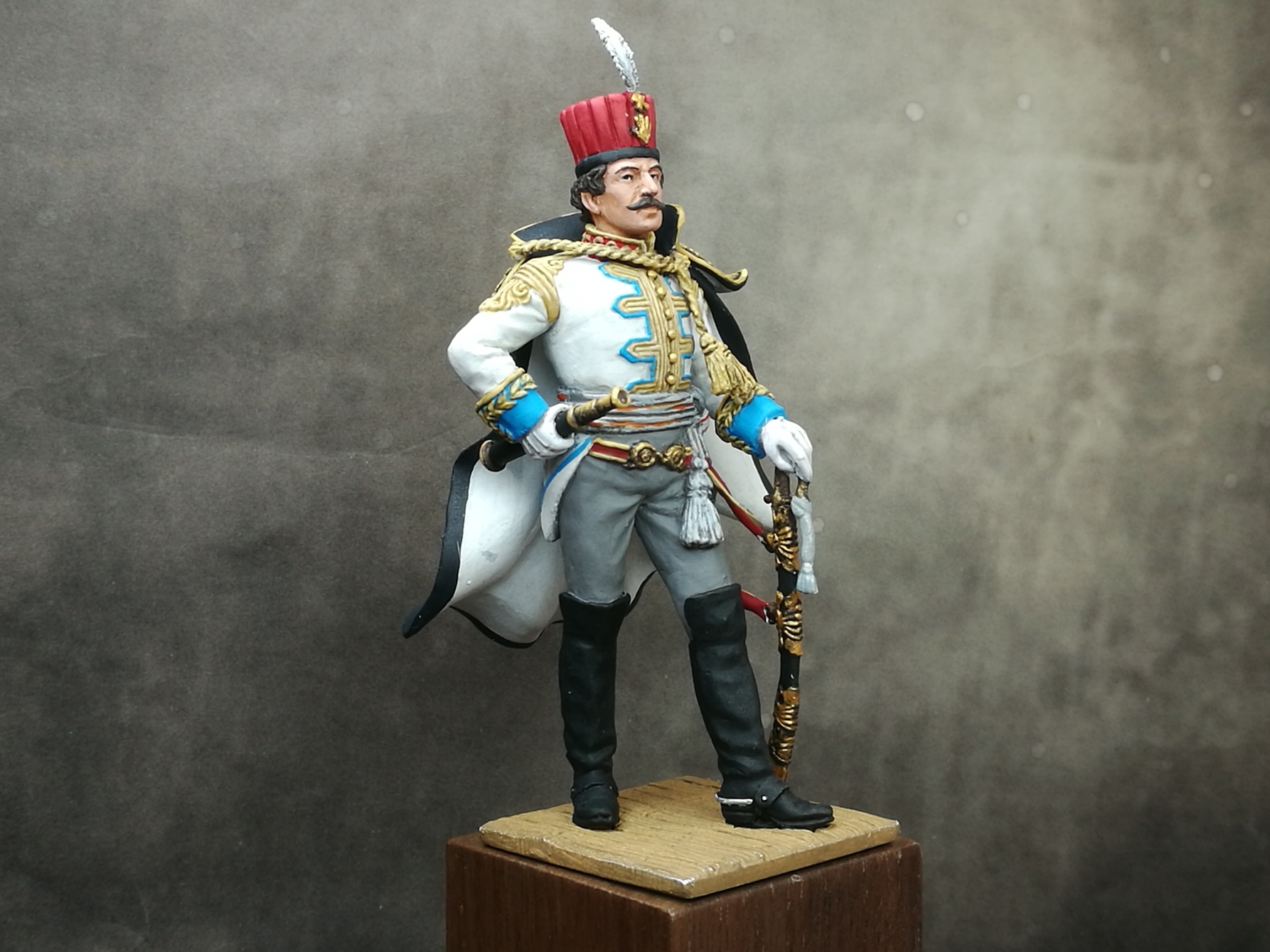




Lambros Katsonis (1752–1804) was a Greek revolutionary hero of the 18th century; he was also a knight of the Russian Empire and an officer with the rank of colonel] in the Imperial Russian Army (or Navy), decorated with an Order of St. George, IV class medal.
Born in Levadia , Central Greece, he joined the Orlov Revolt in 1770, but not pleased by the result he built up a small fleet and began harassing the Ottomans in the Aegean Sea. In 1778 he assembled a Greek pirate fleet of seventy vessels, which harassed the Turkish squadrons in the Aegean and forced the Ottomans to abandon the island of Kastelorizo; the castle on the island was renamed to Lambros Katsonis Castle. In 1790 he was defeated at the Battle of Andros. Katsonis had his hideout in the bay of Porto Kagio. His crew grew very restless and they attacked and sunk two French naval ships. This caused the French to join with the Ottomans to try to stop Katsonis. They cornered him at Porto Kagio and Katsonis' navy was destroyed. Katsonis escaped to Odessa and Yalta where he was granted the Livadia estate —what was later to become the Livadia Palace estate— by Catherine the Great. He lived out the rest of his days there. He was also the godfather of Odysseas Androutsos, a commander of the Greek War of Independence. The Livadia Palace, the summer home of the last Tsars was built on Katsonis' Livadia estate after 1861. The name of the estate was given to it by Katsonis, who named it after his birthplace; moreover, this is the origin of the name of Livadiya town itself. It is there that the World War II Yalta Conference took place.
The Hellenic Navy has named four of its ships after Katsonis.
Nikolaos VOTSIS ( 1877 - 1931 ) , Lieutenant of Greek
Royal Navy, Balkan Wars 1912 - 1913 ( code 5936
)





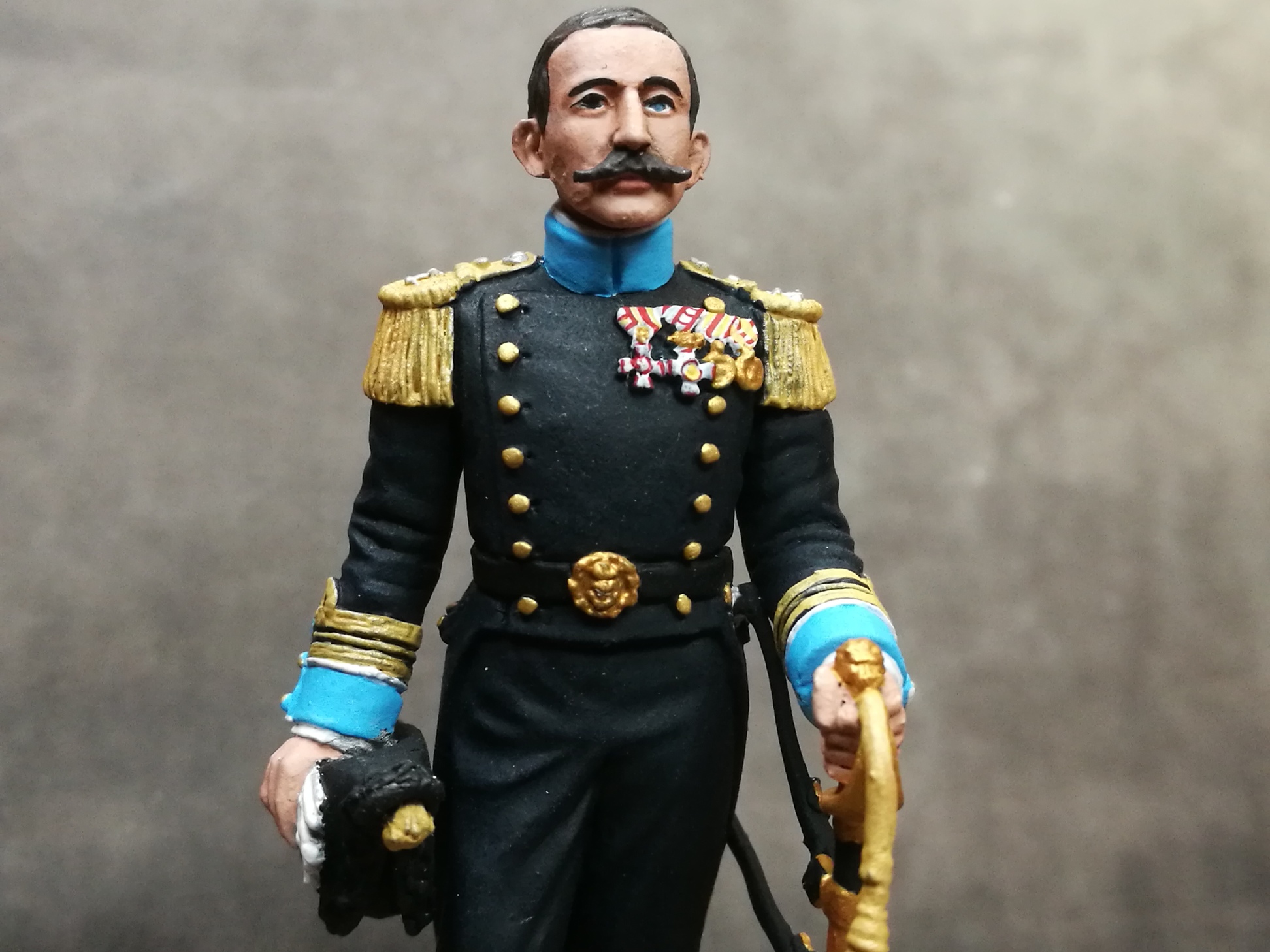
Nikolaos Votsis (1877–1931) was a Greek naval officer who distinguished himself during the Balkan Wars and rose to the rank of Rear Admiral.
Votsis was born in the island of Hydra in 1877. He belonged to the prominent Votsis-Kountouriotis family: he was the nephew of admiral Pavlos Kountouriotis, while his maternal great-grandfather was Georgios Kountouriotis, participant of the Greek War of Independence. At the outbreak of the First Balkan War in October 1912, with the rank of Lieutenant, he was commanding torpedo boat No. 11, a vessel already old at the time (it belonged to a batch of six constructed in Stettin in 1884). Setting sail from his base at Litochoro, on the night of 31 October 1912, Votsis led his vessel into the harbour of Thessaloniki, at the time still held by the Ottomans. Inside the harbour, which was protected by minefields and coastal batteries, lay a handful of Ottoman vessels: aside from four tugboats, the only warship was the old ironclad Feth-i Bülend. The ship had been disarmed and converted into a barracks ship, with its weaponry having been used to reinforce the coastal batteries. Promoted to Lt. Commander, he was placed in command of the captured Ottoman torpedo boat Antalya, which was renamed to Nicopolis.In 1920, he was captain of the battleship Kilkis at anchor at Constantinople. On 27 January 1921 , he was appointed as Greece's High Commissioner to the Allied mission at Constantinople, a post he held until 22 February 1922 , when he was appointed captain of the battleship Lemnos, which he commanded until September 1922.

240 years of Greek Naval History - From Lambros Katsonis to Pavlos Koundouriotis
Katsonis
- Bouboulina - Kanaris - Miaoulis - Votsis -
Koundouriotis

BYZANTINE SOLDIERS
From left to right : BYZANTINE INFANTRY OFFICIAL
VI Century A.D. ROMEO 54066 - STRATIOTES BYZANTINE INFANTRYMAN -
KATEPANIKON OF FRONTIERS 1354 , AITNA 54017
- BYZANTINE SOLDIER 1295 , 54018
AITNA - BYZANTINE
BOWMAN , ROMEO 5402

150 Years of Greek Presidential
Guard 1868 -
2018
The first page of Greek Presidential Guard was
written on December 12 1868 when a Royal
Decree was issued by King George I establishing
four (4) Evzone Battalions. The Palace Guard was
established by the Royal Decre of March 21,1914 in order to
guard the palace. It consisted of two Evzone platoons. The
Evzones in the Guard were alll strictly selected based on their
physical caracteristics, height and ethos . In 1974 the Palace
Guard was named Presidential Guard,



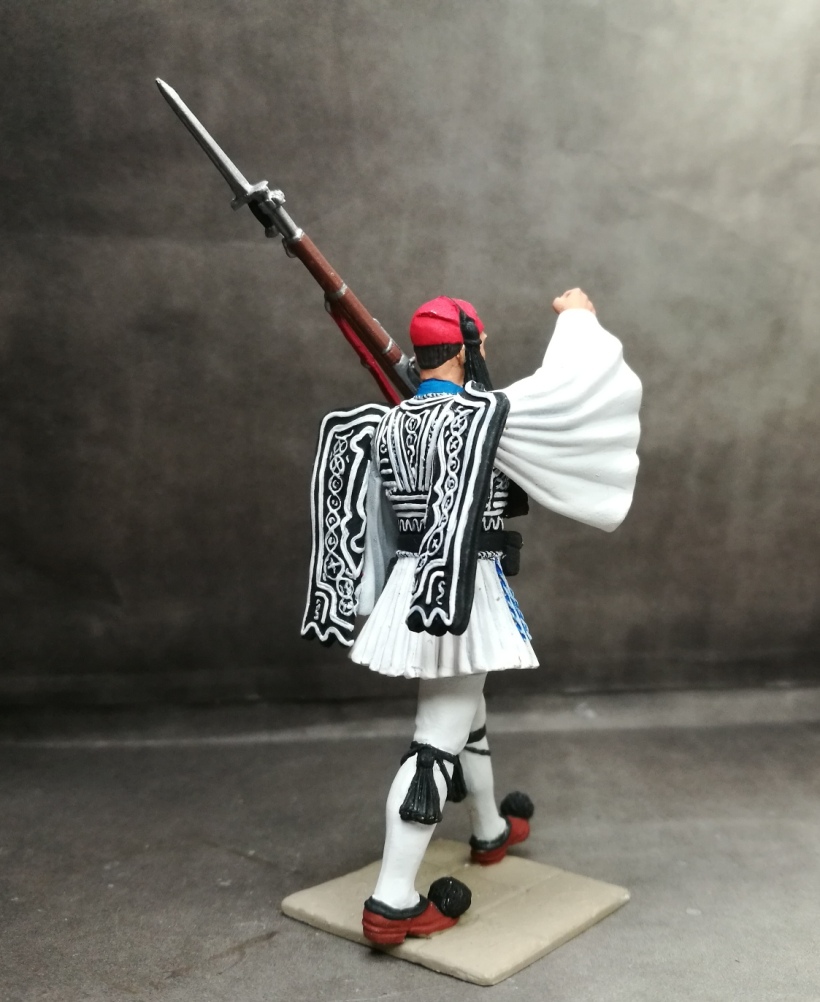

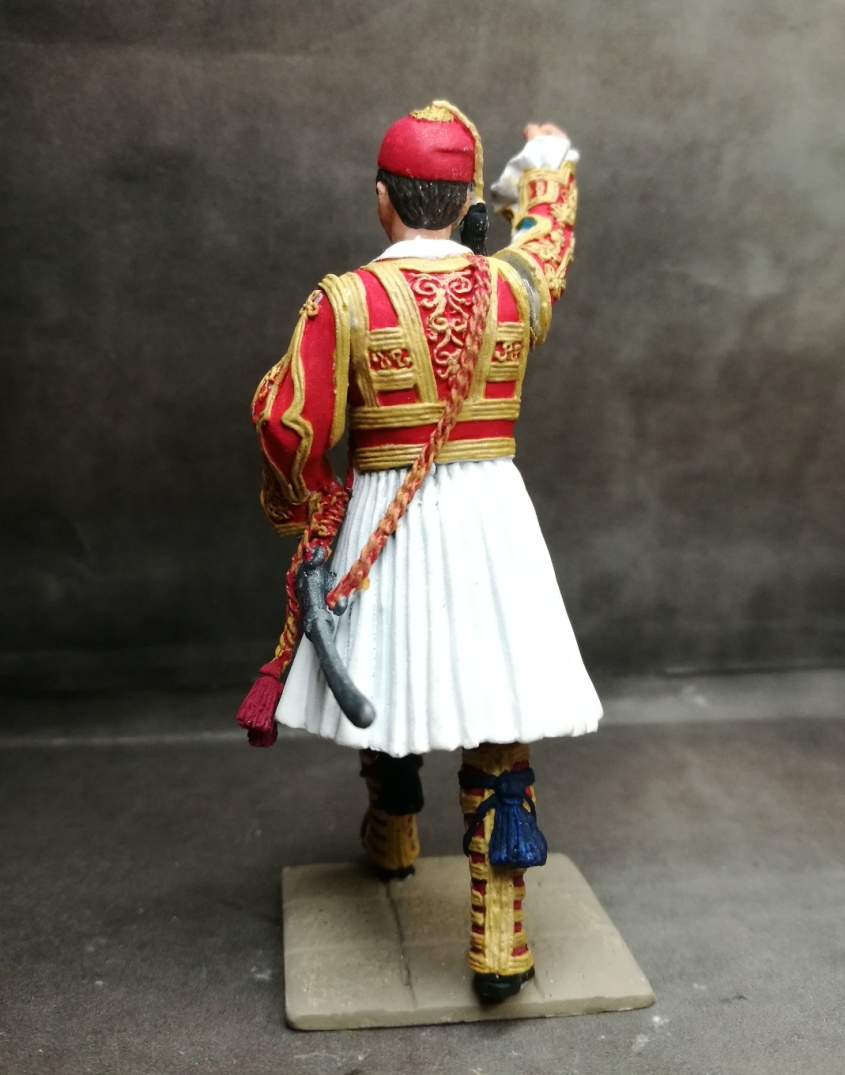
Presidential Guard Evzone in ceemonial
Dress
Evzone Officer marching




Standard Bearer Evzone
marching
Evzone in Winter Dress (Doulamas)




Evzone in Summer
Dress
Evzone in ceremonial Dress presenting arms.
EVZONE DEFENDING - Asia Minor Campaign 1922



ALEXANDER
THE GREAT'S ARMY




Argyraspis
5064,3
Argyraspis in battle
5064,4 by St George
Cross
EVZONE - 4th Battalion (1868 - 1888)




Four Evzone battalions were formed by the R.D. Royal
Decree of 12 December 1868. The collar was red for the 1st Evzone Battalion,
green for the 2nd Battalion, orange for the 3rd Battalion and
light blue for the 4th Battalion New
Evzone uniform was based on the Greek national costume; this was
the first time that Greek soldiers appeared in their world-renowed
uniform as Evzones. At the top , near the shoulder, was the
battalion number sewn in red woollen thread (as it is shown in
picture No 3. ( The figure is based on a painting of
Yiannis Mylonas)
Three more ALEXANDER THE GREAT figures by SaintGeorge cross
a)
Offering ssacrifice to the Gods, b) Alexander as Amon Ra in Egypt,
c) Alexander in Babylon
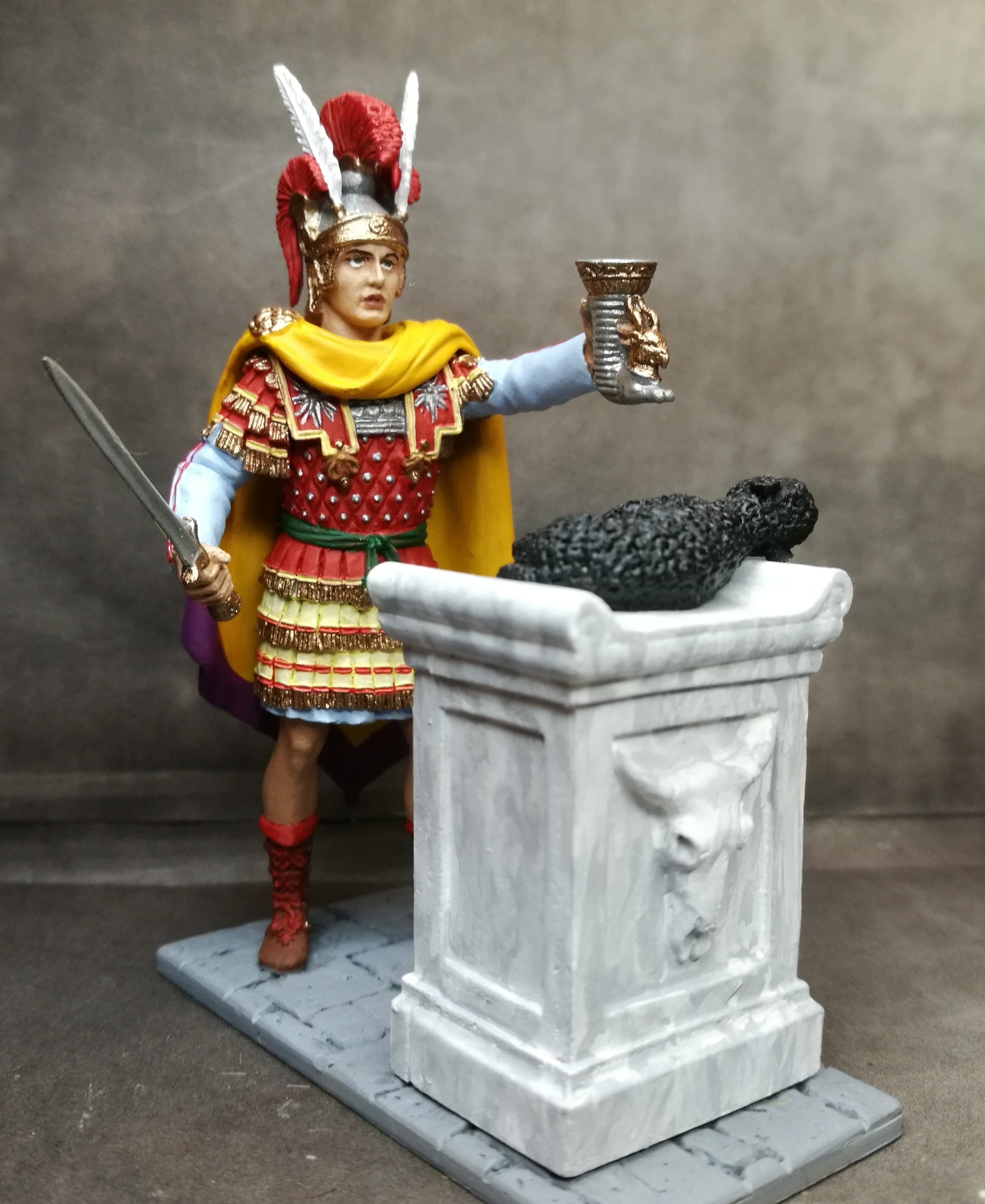


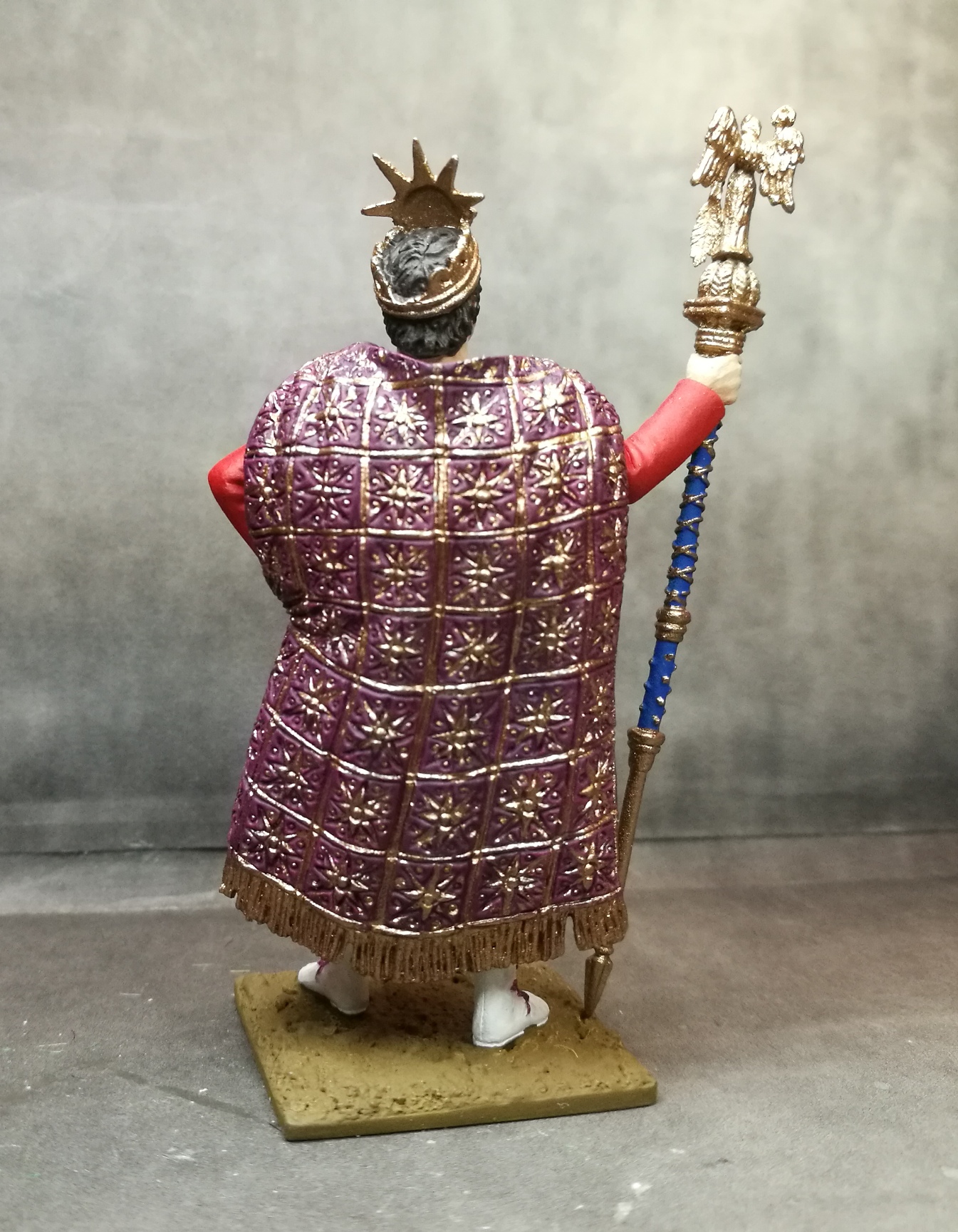
" THE GREEK SENTINEL " , inspired by a painting of the Serb (austrian) painter Paja Jovanović (Paul Joanovitch).
The miniature
weights 367 grammars




GREEK
WAR OF INDEPENDENCE 1821 " Refilling the
gun "
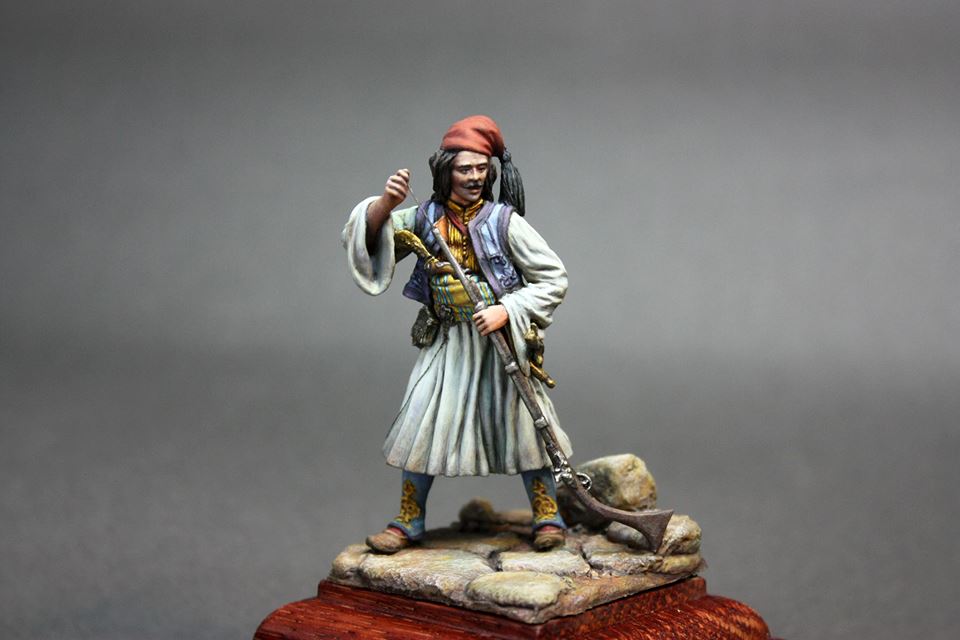



And in large
base with a cannon




Greek
Macedonian Sarissoforos - Alexander the Great
Army by St GeorgeCross
code 5068

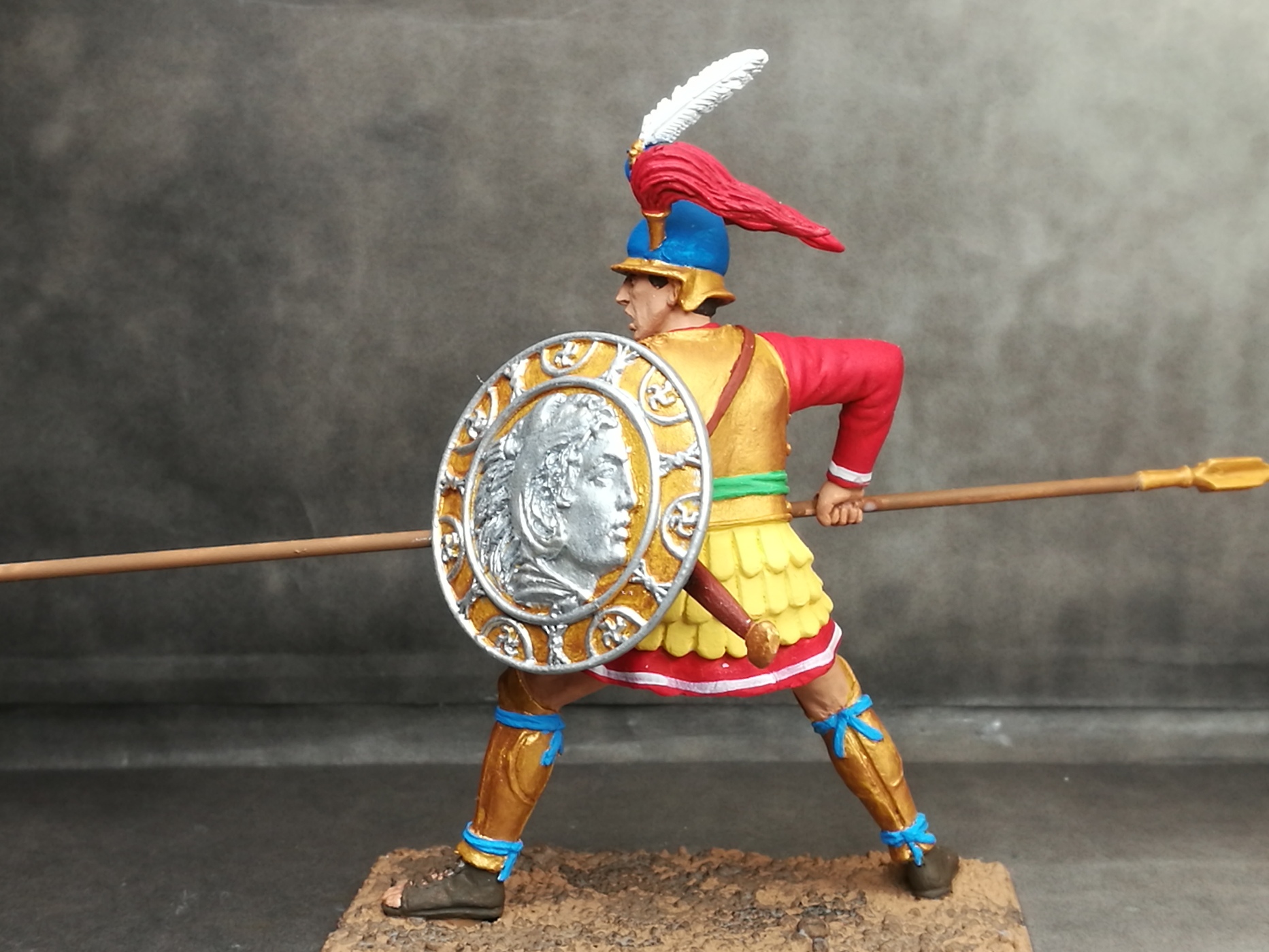


GREEK EVZONE Corporal - Greco -
Turkish War 1897








The blue doulamas became part of
the Evzone;s uniform in 1888. The
cuff was knocked on the chest with two non-parallel rows of 14
round spherical golden metal buttons. At the top, horizontally with the chest, there were 12
buttons. The collar of the Infantry Evzone was red with black band
. The blue doulamas
replaced the Evzone's capes. In the picture Greek Evzones
with blue doulama dance befora a battle in Peta area during the
1897 war.
BYZANTINE
EMPERORS
Constantine The Great (Art Girona) - Justinian The Great (Art Girona) - Basil II , The Bulgar slayer (Greek Heroes)
Alexios Komnenos (Greek
Heroes) - Manuel Palaiologos ( St George Cross) - Constantine
Palaiologos (GreeK Heroes)

Byzantine Emperor
MANUEL II PALAIOLOGOS 1405



Manuel II Palaiologos or Palaeologus (Greek: Μανουήλ Β΄ Παλαιολόγος, Manouēl II Palaiologos; 27 June 1350 – 21 July 1425) was Byzantine Emperor from 1391 to 1425. Shortly before his death he was tonsured a monk and received the name Matthew. His wife Helena Dragaš saw to it that their sons, John VIII Palaiologos and Constantine XI Palaiologos, become emperors. Manuel is commemorated on July 21. Manuel II Palaiologos was the second son of Emperor John V Palaiologos and his wife Helena Kantakouzene.
Hearing of his father's death in February 1391, Manuel II Palaiologos fled the Ottoman court and secured the capital against any potential claim by his nephew John VII. Although relations with John VII improved, Sultan Bayezid I besieged Constantinople from 1394 to 1402. After some five years of siege, Manuel II entrusted the city to his nephew and embarked (along with a suite of 40 people) on a long trip abroad to seek assistance against the Ottoman Empire from the courts of western Europe, including those of Henry IV of England (making him the only Byzantine emperor ever to visit England – he was welcomed from December 1400 to January 1401 at Eltham Palace, and a joust took place in his honour), Charles VI of France, Sigismund the Holy Roman Emperor, Queen Margaret I of Denmark and king Martin of Aragon. In 1399, the French King Charles VI sent Marshal Jean Le Maingre with six ships carrying 1,200 men from Aigues-Mortes to Constantinople; later 300 men under Seigneur Jean de Chateaumorand remained to defend the city against Bayezid. Manuel II died on 21 July 1425. Manuel II was the author of numerous works of varied character, including letters, poems, a Saint's Life, treatises on theology and rhetoric, and an epitaph for his brother Theodore I Palaiologos and a mirror of prince for his son and heir Ioannes. This mirror of prince has special value, because it is the last sample of this literary genre bequeathed to us by Byzantines.


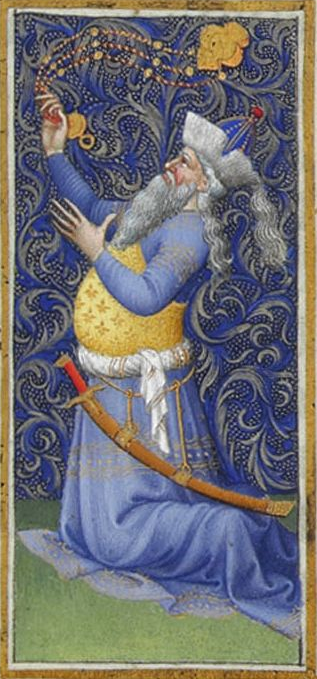
Manuel II Palaiologos as Melchior (one of the three Magi), Tres Riches Heures Heures du Duc de Berry, fol 51 ( second picture ) - Manuel II Palaiologos as Augustus , Tres Riches Heures Heures du Duc de Berry, fol 22 third picture ) .
A WWII
Greek Army vignette by Kostas LAIOS


GREEK ARMY WWII
Some conversions of Greek soldiers
WWII

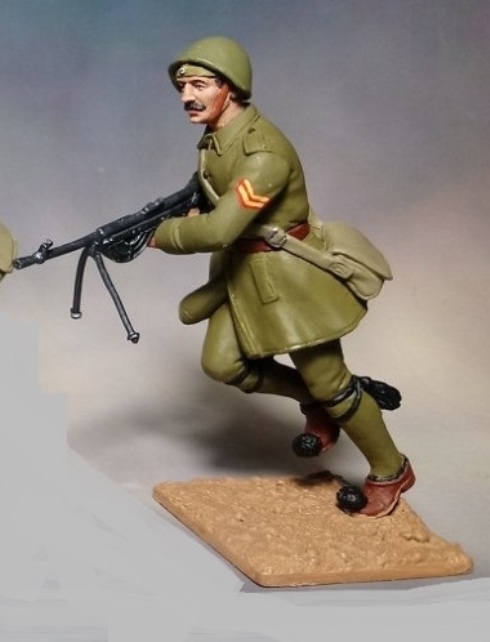


Evzone , Sargeant ,Greek Light Infantry,
1940
Greek soldiers November 1940 marching to the
front
More ALEXANDER'S
ARMY SOLDIERS by St George Cross
In 54mm


BALKAN ARMIES DURING BALKAN WARS and WWI ( Greece - Turkey - Romania - Bulgaria - Serbia - clockwise )
Figures from "Warrior" company in 54mm .
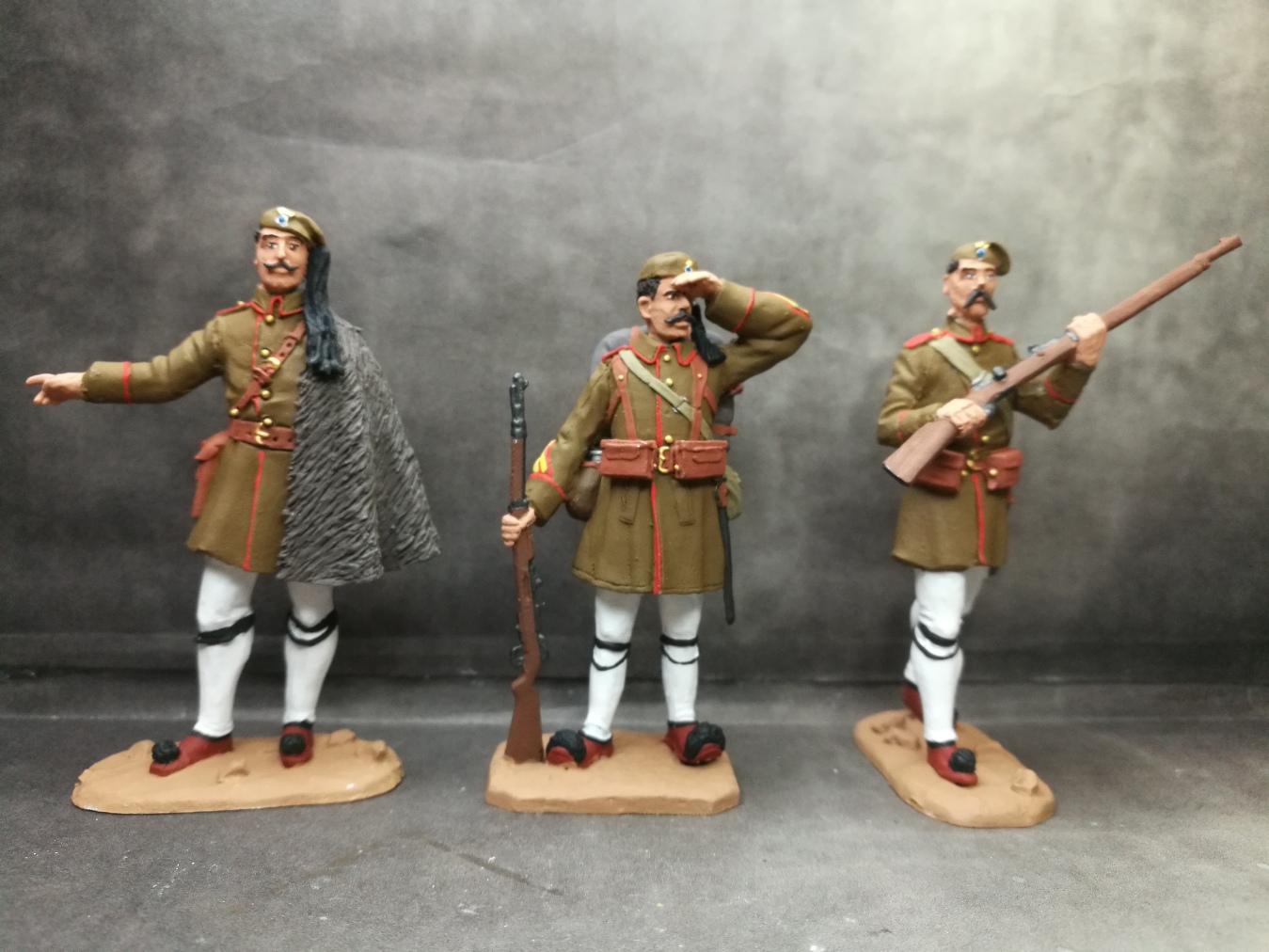

GreeK Evzones , Balkan Wars 1912 - WWI
1916
Turkish Artillery Captain with LP08 (Artillery Luger
1917 - Turkish soldier WWI


Serbian Army 1912 , Lieutenant general and serbian
soldier Romanian
infantry, first Lieutenant and infantry corporal WWI
1917


Bulgarian army - First lieutenant of elite infantry
regiment "Ferdinand " - Balakn Wars 1913

BALKAN
ARMIES WWI ( 1914 - 1918
)
Turkish
Army - Romanian Army - Serbian
Army
GREEK BATTALION OF BALAKLAVA 1797 - In the service of Imperial Russian Army .
A figure in 54mm of an out of stream subject
by " Tin Parade" company .
The Greek Battalion of Balaklava was a military unit of the Imperial Russian Army which participated in the Russo-Turkish wars of 1768–1774, 1787–1792 and 1806–1812. It was consisting of Greek expatriates who were living in the Balaklava area.
Initially the battalion was named "Greek Infantry Regiment" and in 1797 was renamed to "Greek Balaklava Battalion". Its Greek soldiers were from the Peloponnese, the Aegean islands, the Ionian Islands and the Venetian dominions in Albania. They were experienced in guerrilla warfare and contributed significantly to the Russian annexation of Crimea and the expulsion of the Ottomans from the area.
The base of the Greek Infantry Regiment was Balaklava after the imperial decree of February 18, 1784. The soldiers settled in Balaklava with their families, a total number of about 500 adults in 1778, increased to about 1,700 in 1802.
According to the April 4, 1797 imperial decree the battalion was composed of three companies, each having 100 soldiers. Including officers and other staff its total force amounted to 396 people. The soldiers were issued red and green uniforms and weaponry of the same type. The battalion was disbanded in 1859.
BYZANTINE
SOLDIER 1204 A.D. code
5309


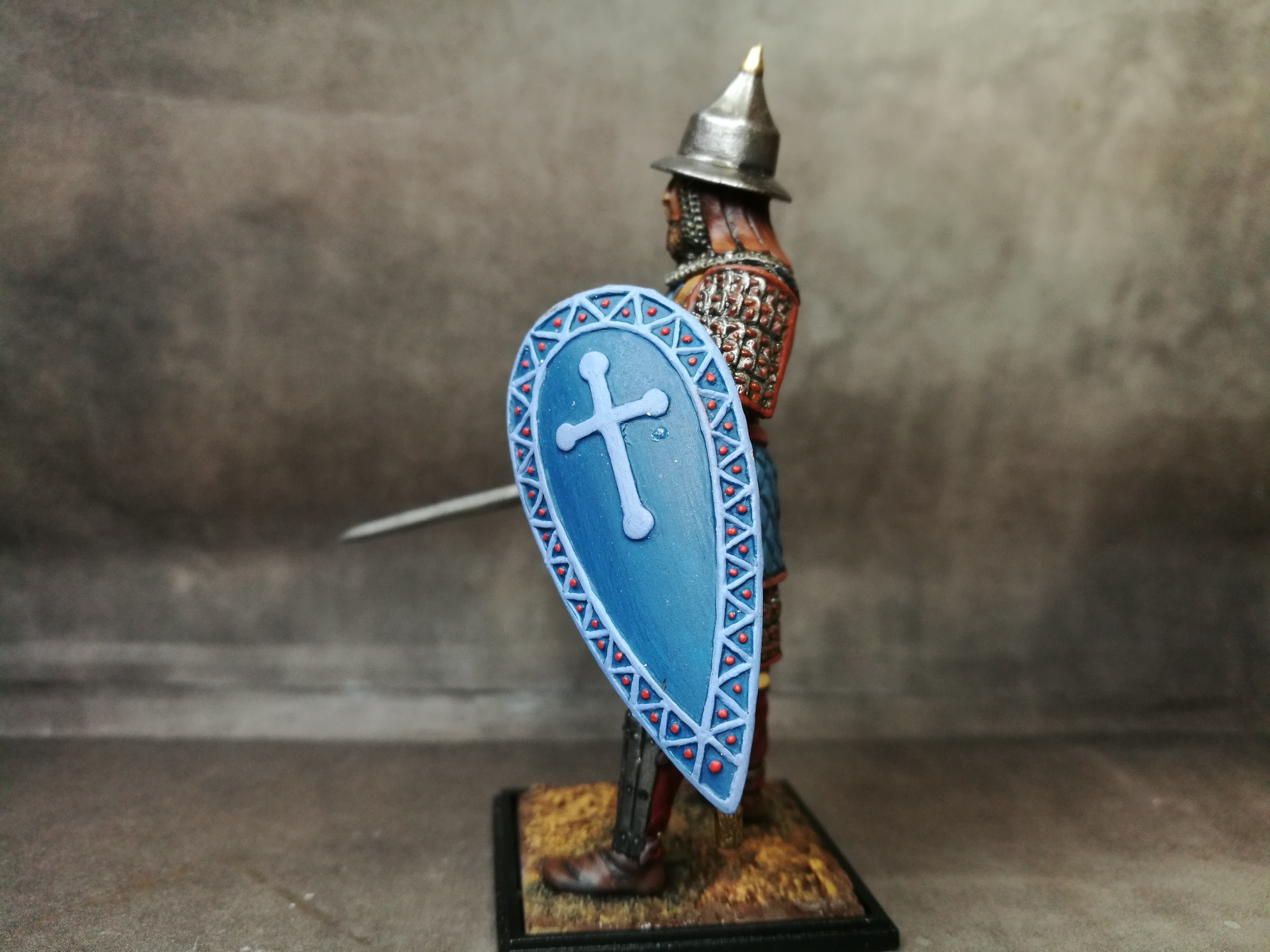


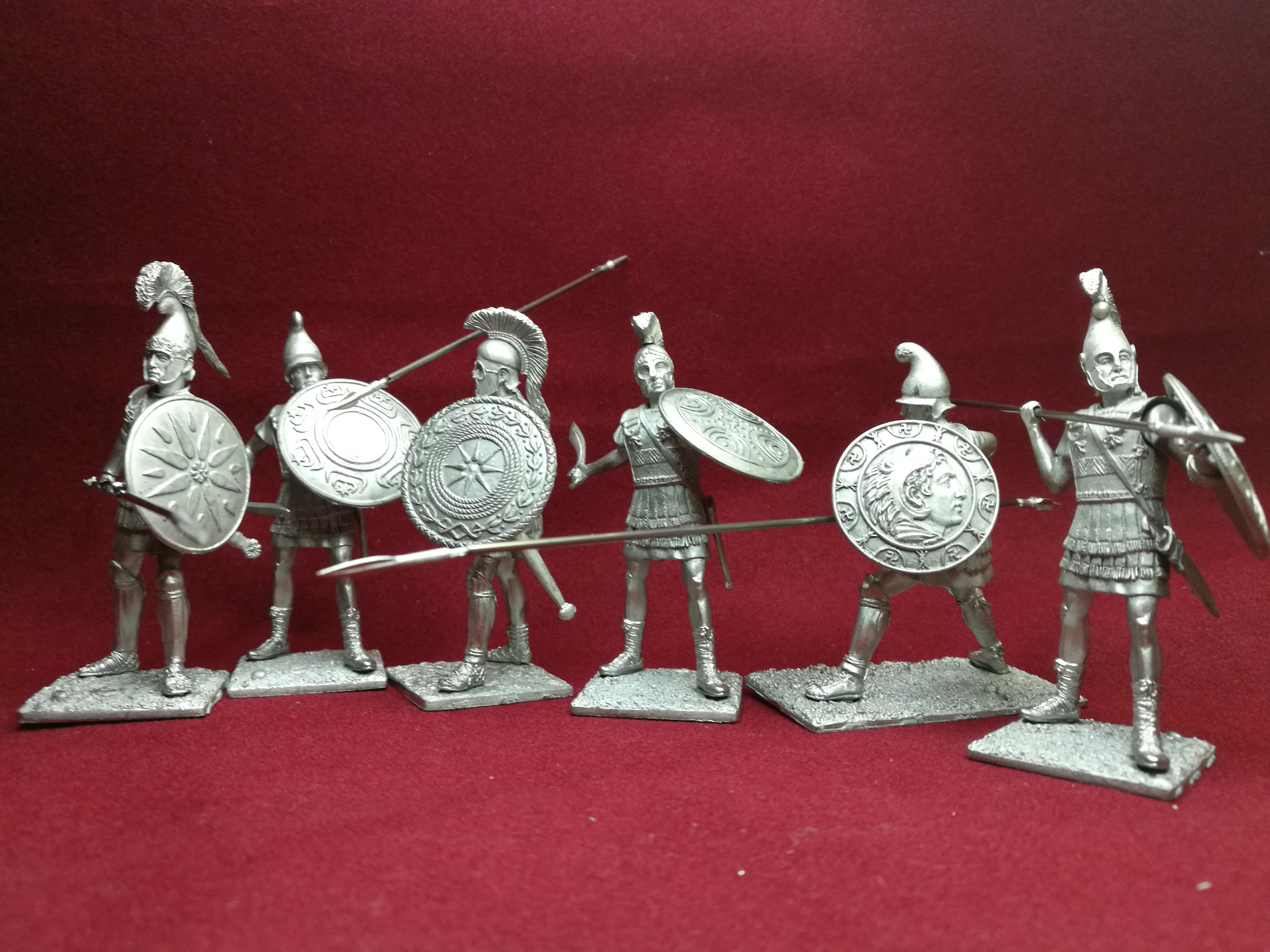
ALEXANDER THE GREAT ARMY is
here. Sarissofors, Hypaspists, Pezetairoi, Foot
Companions , Argyraspists all are here ... A new
series of Greek Macedonians from Saint George company
.

GREEK
OFFICER - BATTLE OF HILL 731 - MARCH 1941
( code 5940 )




The Battle of
Hill (Height) 731), was a fierce battle fought during
World War II in southern
Albania, part of the
Greco-Italian War. It began
in the early morning of 9 March 1941, when Fascist Italy launched an
assault (Operation
Primavera) against Greece, aimed at capturing
the critical mountain pass leading into the Kalpaki valley. Hill 731,
strategically located 20 km north of Klisura (Këlcyrë) at the feet of
Mount Trebeshinë, stood at
the heart of the Greek defensive line. Despite being repeatedly and
heavily attacked by superior Italian forces for over two weeks,
Hill 731 was not captured, contributing to the failure of the
Primavera offensive and the repulsion of
Italians.
The sleeve is simple, with a series of 5 metal buttons. The
sleeve has 4 outer pockets covered in parallel caps, which were
small smooth metal buttons.
The pants are short in the shape of a riding panty, made of khaki
woolen cloth.
He wears woolen stripes, khaki color and simple soldier's shoes.
The helmet is Greek made in 1938.
It has accessories made of brown leather. The belt is an
English-style Sam Braun, a gun holster and a briefcase for papers
and maps.
The spindle is Belgian, Nagat M 1898.
EVZONE BALKAN WAR
II - Battle of Kilkis 1913
(code
5935)
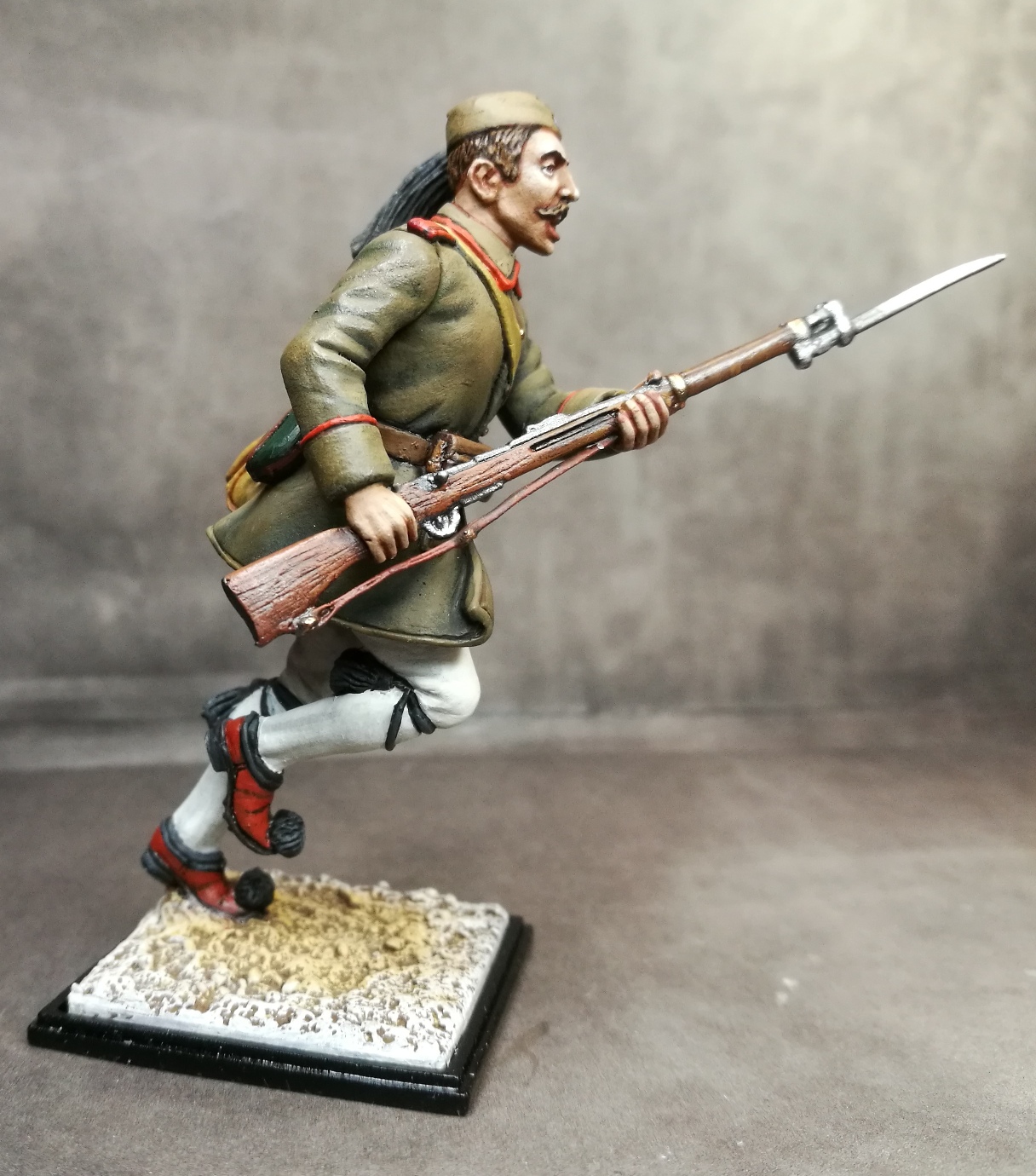





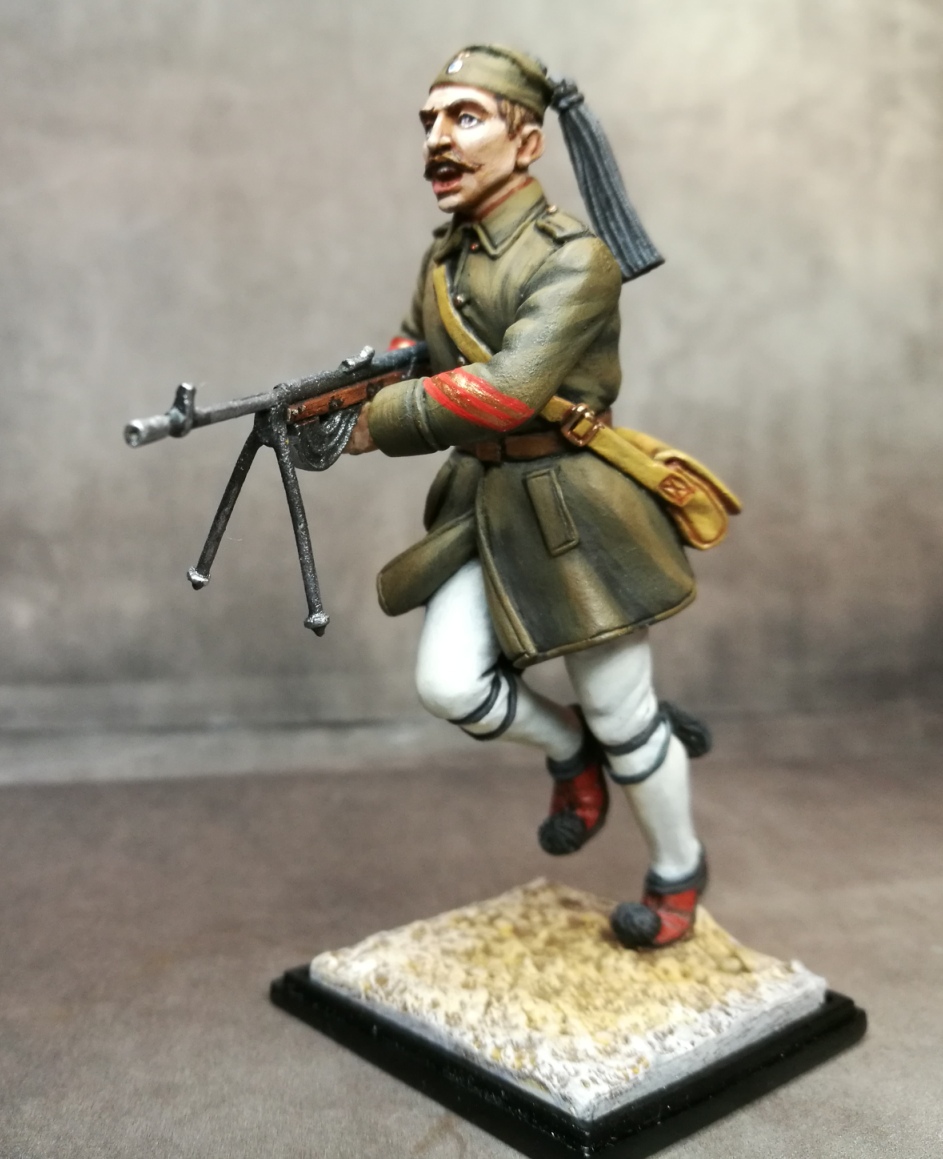

Greek Soldier 1940 (code 5940,2 )
Evzone with machine gun 1921 (code 5935,2)
Greek Lieutenant 1940 WWII (code 5941)
GREEK LIEUTENANT 1940 -
WWII
code
5941




The sleeve is simple, with a series of 5 metal buttons. The
sleeve has 4 outer pockets covered in parallel caps, which were
small smooth metal buttons.
The pants are short in the shape of a riding panty, made of khaki
woolen cloth.
He wears woolen stripes, khaki color and simple soldier's shoes. It
has accessories made of brown leather.
The belt is an English-style Sam Braun, a gun holster and a
briefcase for papers and maps.
The spindle is Belgian, Nagat M 1898.
GREEK SOLDIER 1940
WWII
code
5940,2
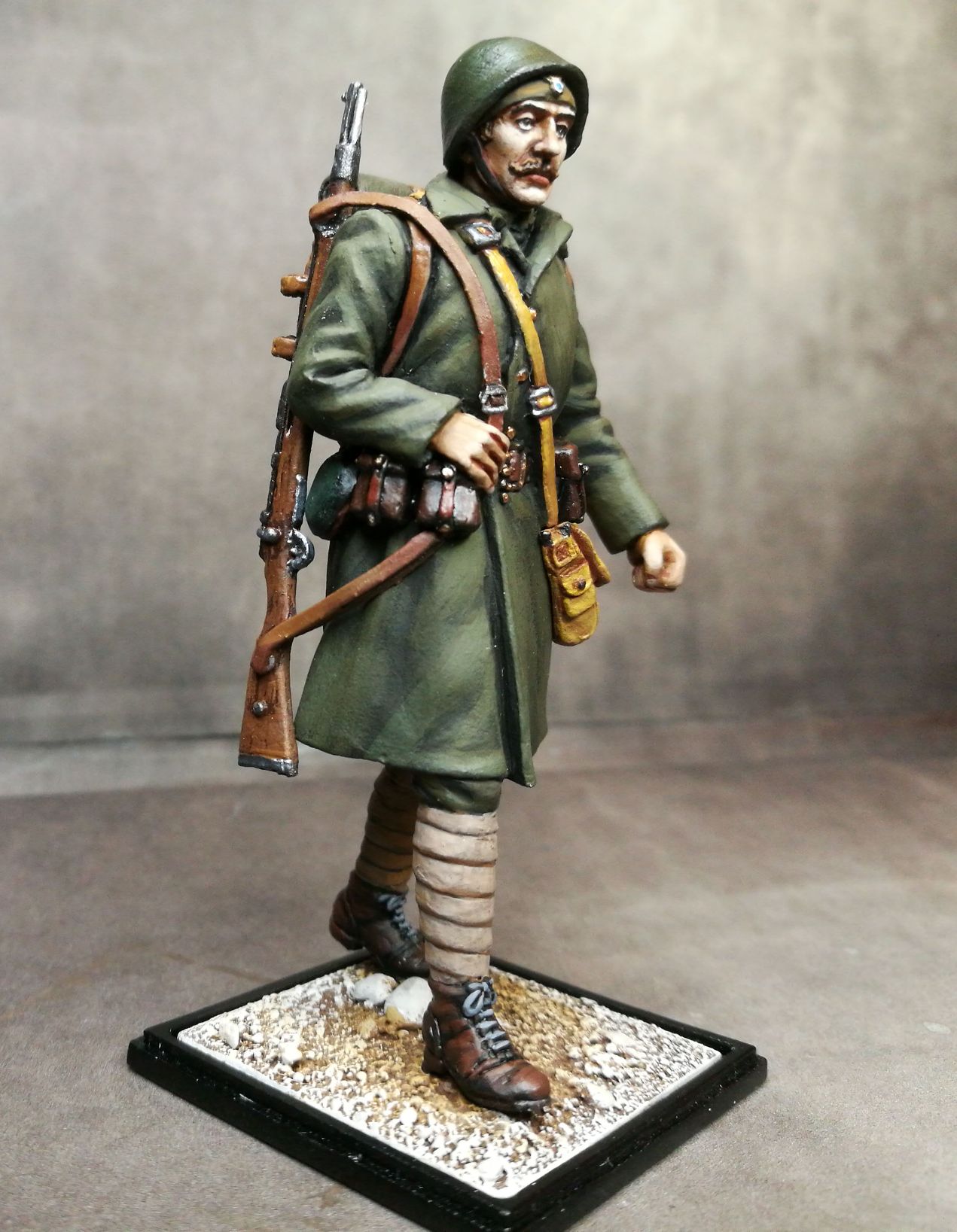

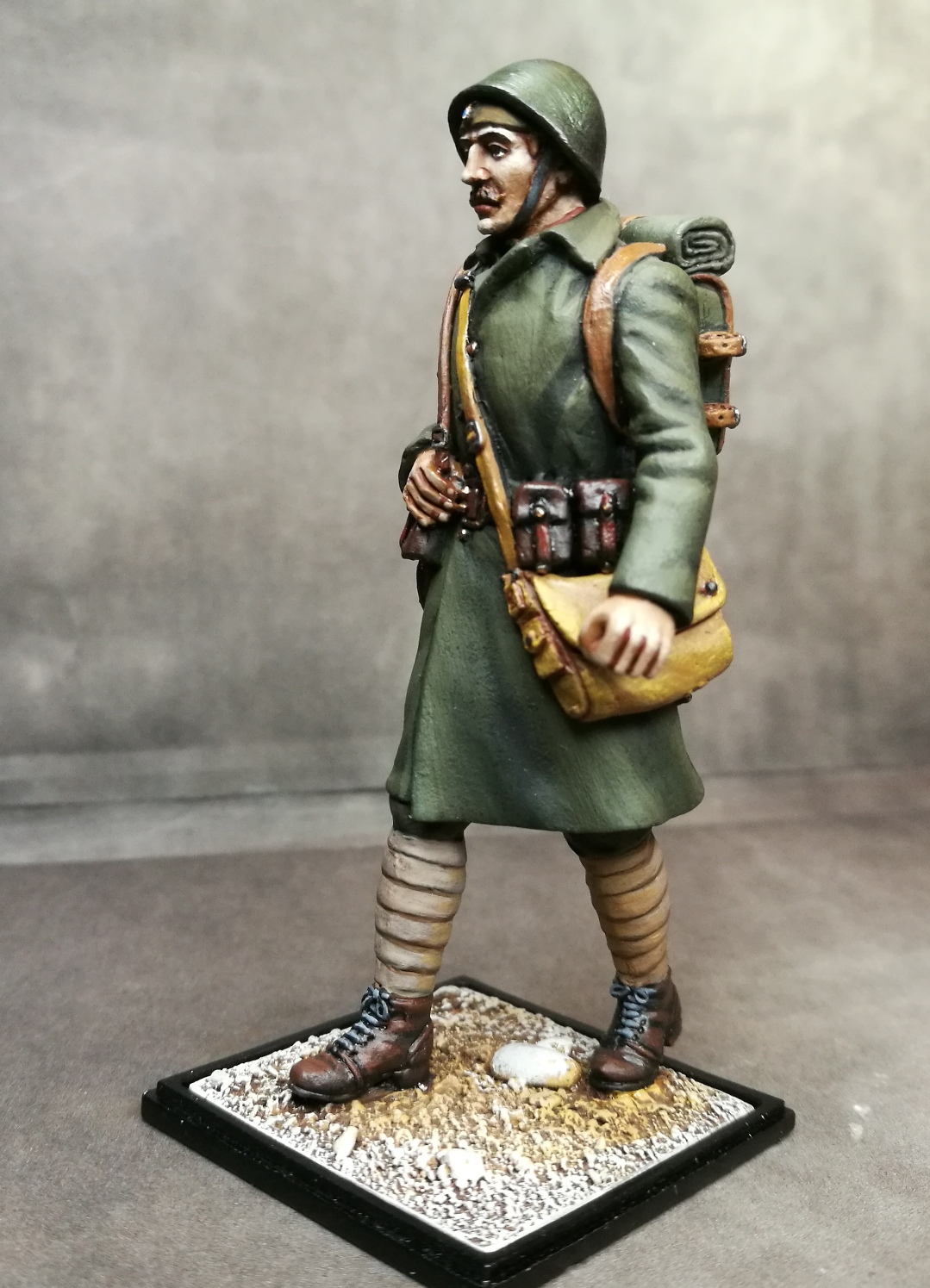




EVZONE
with machine gun - Battle of Dorylaion ( Eski Sehir ) 8-7-1921 ( code
5935,2)




Evzone carries a French supplied “ Chauchat “ LMG and is armed for self-defence with a holstered Steyr M1905 semi-automatic pistol.
The traditional Evzone uniform consists of khaki farion ( though the black tassel was usually removed in the field) and doulama coat over a fustanella kilt and long gartered woolen stockings. His rank of sergeant is indicated by the yellow stripes on red packing on his coat sleeves.
His pigskin Tsarouchia (mountain shoes ) with black pompons were sturdy and confortable.
GREEK
LIGHT INFANTRY 1838 - Private - code
5731




GREEK LIGHT INFANTRY 1838 , Private, Battalion from Roumeli GREEK LIGHT INFANTRY 1838, Private, Battalion from Mani



The uniforms of privates in the Light Infantry Battalions were
almost the same. Those from Roumeli (Sterea Ellas) differed from
the troops from Mani (South Peloponese) due to their blue
waistcoats with a blue collar and silver buttons. Soldiers had
shiny black leather accoutrements. Their belt had a brass
buckle, two small black leather cartridge belts at the back
and a leather sword sling on the left. Their arms consisted of a
French or Russian made M1777 infantry rifle with bayonet and
a short German infantry M1810 sabre. Figure are based on a
watercolor of bavarian Ludwing Kollnberger , who served in
the Greek Army from 1832 till 1859.
General
KOSTAS BOTSARIS (1792–1853) King's Otto
Army
Στρατηγός
ΚΩΣΤΑΣ ΜΠΟΤΣΑΡΗΣ



Kostas (Kitsos) Botsaris (Greek: Κώστας (Κίτσος) Μπότσαρης, Italian : Costa Bozzari, c. 1792–1853)also known as Constantine Botzaris, was a Greek general and senator and a Souliot captain and a hero of the War of Greek Independence. He fought at the Battle of Karpenisi and completed the victory of his brother, the renowned Markos Botsaris.
After the death of his brother Markos Botsaris, Kostas lived on to become a respected Greek general and parliamentarian in the Greek Kingdom. Fifteen years after the death of his brother, the American traveller and author Mr. John Lloyd Stephens visited Kostas Botsaris, then a colonel in the service of King Otto of Greece in Missolonghi, and described him as:
| “ | " A man of about
fifty years of age, of middle height and spare build, who,
immediately after the formal introduction, expressed his gratitude
as a Greek for the services rendered his country by America; and
added, with sparkling eye and flushed cheek, that when the Greek
revolutionary flag sailed into the port of Napoli di Romania, among
hundreds of vessels of all nations, an American captain was the
first to recognize and salute it." Botsaris continued to serve in the Greek kingdom until his death in Athens on 13 November 1853. |
Major IOANNIS VELISSARIOU code 5929 BALKAN WARS 1912 -1913 Greek Army
Ταγματάρχης Ιωάννης
ΒΕΛΙΣΣΑΡΙΟΥ ΒΑΛΚΑΝΙΚΟΙ ΠΟΛΕΜΟΙ 1912
- 1913




Ioannis Velissariou (Greek: Ιωάννης Βελισσαρίου, 26 November 1861 – 13 July 1913) was a Greek Army officer and hero of the Balkan Wars. He is considered to be one of the most important figures in the military history of modern Greece. He is considered to have had a decisive role in the Battle of Bizani during the First Balkan War (1912–1913), forcing the Ottoman Army to surrender unconditionally. Velissariou participated in the Second Balkan War against Greece's erstwhile ally Bulgaria, initially in the Battle of Lahanas and then in the Battle of Kresna Gorge. After the Greek Army managed to break through the Kresna pass, it captured the town of Simitli, while the battalion of Velissariou, together with other two of the 1st Evzone Regiment, fought at Summit 1378, 20 kilometres (12 mi) northeast of Simitlii. Although the specific sector suffered constant attacks by the Bulgarian Army, the Evzones managed to repel them. During the conflict of 13–15 July, the Regiment suffered numerous casualties; Major Velissariou was one of the officers killed. He was buried near the battle site.
REVIEW http://figuresinscale.freeforums.org/major-ioannis-velissariou-by-greek-heroes-models-t63.html
Colonel Nikolaos PLASTIRAS "
The Black Rider "( 1883 – 1953
) - commanded the
5/42 Evzone Regiment
in Asia Minor
(1919 – 1922
)
Prime Minister 1945, 1950,
1951-1952. code
5932



Nikolaos Plastiras ( 4 November 1883 – 26 July 1953) was a Greek general and politician, who served thrice as Prime Minister of Greece. A distinguished soldier and known for his personal bravery, he was known as "The Black Rider" during the Greco-Turkish War of 1919-1922. After the Greek defeat in the war, along with other Venizelists officers he staged a coup against King Constantine I of Greece and his government. The military-led government ruled until January 1924, when power was handed over to an elected National Assembly, which later declared the Second Hellenic Republic. In theinterwar period, Plastiras remained a devoted Venizelist and republican. Trying to avert the rise of the royalist People's Party and the restoration of the monarchy, he led two coup attempts in 1933 and 1935, both of which failed, forcing him to exile in France.
During the Axis Occupation of Greece in theSecond World War he was the nominal leader of the EDES resistance group, although he remained in exile in Marseilles. After the occupation, he returned to Greece and served as a centrist Prime Minister three times, often in coalition with the Liberal Party. In his last two governments, he tried to heal the rift caused in Greek society by the Greek Civil War, but was unsuccessful.
PAVLOS MELAS 1904
Macedonian struggle code
5933




Pavlos Melas (March 29, 1870 – October 13, 1904) was an officer of the Hellenic Army, and he was among the first who organized and participated in the Greek Struggle for Macedonia. He was born in Marseilles, France, the son of Michail Melas who was elected MP for Attica and mayor of Athens and brother of Vassileios Melas who was also an officer of the Hellenic Army. His father, a wealthy merchant, was of Epirote origin. At an early age Pavlos moved to Athens to study, and later joined the Army, graduating from the Hellenic Army Academy as an artillery lieutenant in 1891. In 1892, he married Natalia Dragoumi, the daughter of Kastorian politician Stephanos Dragoumis and sister of Ion Dragoumis. After the Ilinden-Preobrazhenie uprising, he decided to enter Macedonia in June 1904, to assess the situation and to see if there is any possibility of establishing a military unit to fight the Bulgarians (Internal Macedonian Revolutionary Organization, VMRO) and the Ottoman Turks. In July 1904 (under the alias Captain Mikis Zezas), he reentered Macedonia with a small unit of men and fought against the VMRO until October 13, 1904 when he was killed after being surrounded by Ottoman forces in the village of Statista. The village has been renamed Melas in his honour.
2nd Regiment Greek Light
Infantry (1810-1812) later Greek Light
Infantry ("The Duke of York's") (1812–16)
code 5650



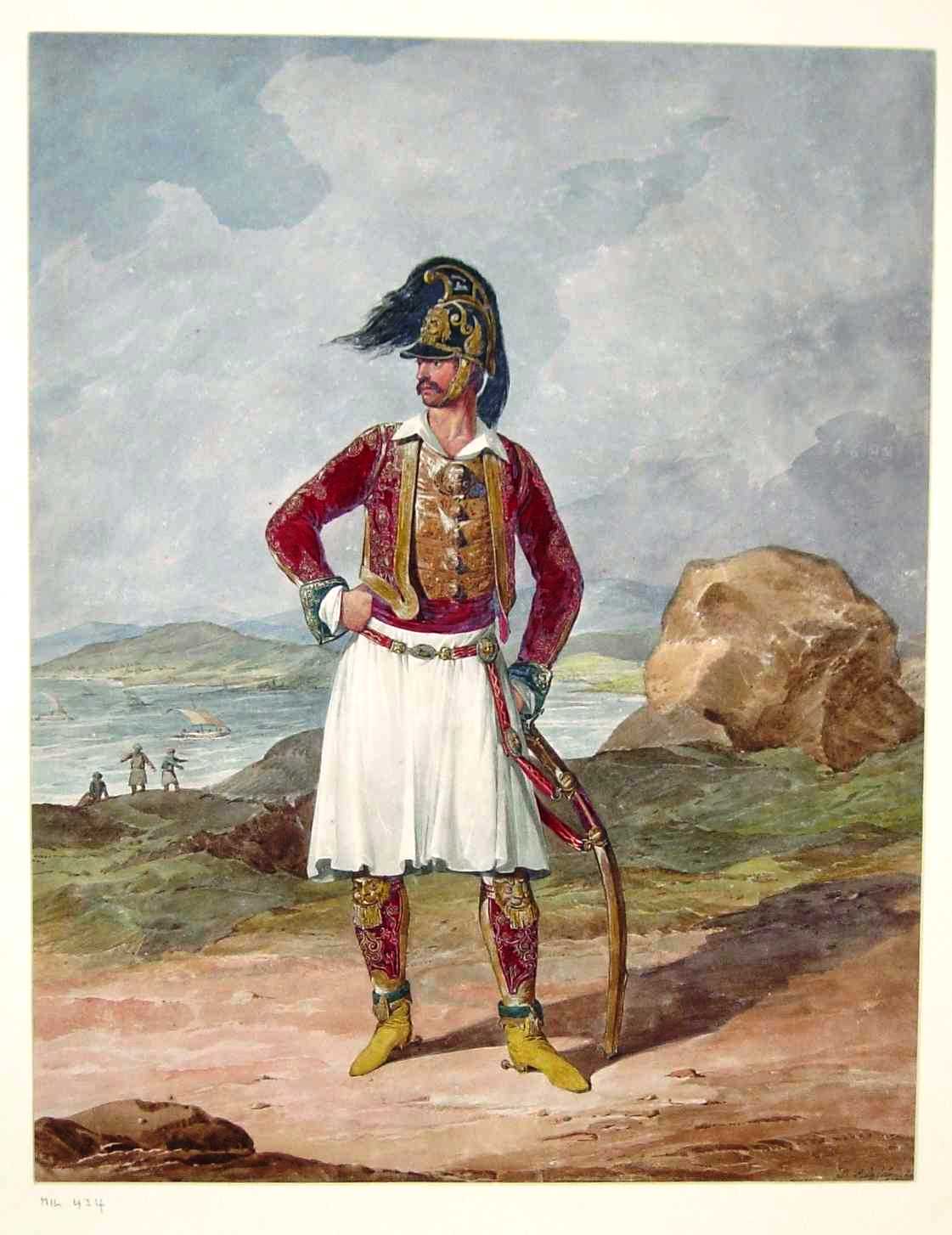
The 1st Regiment Greek Light Infantry (1810–12) was a light infantry regiment, founded as a local establishment in British service consisting mostly of Greek and Albanian enlisted men and Greek and British officers that served during the Napoleonic Wars. Later it became a regular British Army regiment as the 2nd Greek Light Infantry ("The Duke of York's") (1812–16). It had no official association with the modern state of Greece or the Filiki Eteria or any Greek War of Independence groups; however, several future leaders of the War of Independence as Kolokotronis, Plapoutas, Anagnostaras , fought in its ranks, as did a number of rank-and-file klephts and armatoloi.
Officers of 2nd Regiment wore a crested red dragoon-style helmet, as depicted in the drawing of Richard Church and of later drawings of Greek War of Independence (after 1821) leader Theodoros Kolokotronis who continued to wear the helmet. Officers are depicted as wearing taller, higher-heeled three-quarter shoes or short boots. Kolokotronis sported a brace of engraved pistols and an ornate cavalry-style cuirass, which are now on display at the National Historical Museum, Athens. Richard Church was depicted wearing a similar helmet-and-cuirass outfit plus metal greaves and knee protectors with gilt lion's heads along with a braided version of the uniform of the unit's sister regiment, in a painting now housed in the Royal Gallery.
Richard
CHURCH - Battle at Aghia Mavra (Lefkada
island) 1810 code
5650.1




Sir Richard Church (1784 – March 1873), was an Irish military officer in the British Army and commander of the Greek forces during the last stages of the Greek Revolution after 1827. After Greek independence, he became a general in the Greek army and a member of the Greek Senate. He was the son of a Quaker, Matthew Church of Cork. At the age of sixteen he ran away from home and enlisted in the British Army.
In the summer of 1809 he sailed with the expedition sent to occupy the Ionian Islands. Here he increased the reputation he had already gained by forming a Greek regiment in British pay. On the 9th of September 1809 he took the position of Major in the 1st Regiment Greek Light Infantry. He formed a second regiment composed of 454 Greeks 2nd Regiment Greek Light Infantry) to occupy Paxoi islands. These regiments included many of the men who were afterwards among the leaders of the Greeks in the War of Independence including Theodoros Kolokotronis with whom he kept a friendship and correspondence. Church commanded this regiment at the taking of the island of Santa Maura (Lefkada), on which occasion his left arm was shattered by a bullet.
In 1827 he took the honorable but unfortunate step of accepting the commandership-in-chief of the Greek army. On 3 October 1833 he was promoted to Lieutenant General in the Greek Army, and in January 1835 became commander of the forces in Continental Greece. In 1844–45 he was a senator. He was promoted to full general in 1854, and died at Athens on 1873. The funeral monument is at the First Cemetery of Athens
BYZANTINE EMPERORS
A unique series of miniatures about the Byzantine Empire ( East Roman ) and the Emperors who ruled for more than thousand years.


CONSTANTINE
XI PALAIOLOGOS
Last Byzantine
(East Roman ) Emperor (code
5327)
Κωνσταντίνος
ΠΑΛΑΙΟΛΟΓΟΣ
Τελευταίος Βυζαντινός Αυτοκράτωρας



Constantine XI Dragases Palaiologos, Latinized as Palaeologus (Greek: Κωνσταντίνος ΙΑ' Δραγάσης Παλαιολόγος, Kōnstantinos XI Dragasēs Palaiologos; 8 February 1405 – 29 May 1453) was the last reigning Byzantine Emperor, reigning as a member of the Palaiologos dynasty from 1449 to his death in battle at the fall of Constantinople. Following his death, he became a legendary figure in Greek folklore as the " Marble Emperor " who would awaken and recover the Empire and Constantinople from the Ottomans. His death marked the end of the Roman Empire, which had continued in the East for 977 years after the fall of the Western Roman Empire.
Before the beginning of the siege, Mehmed II made an offer to Constantine XI. In exchange for the surrender of Constantinople, the emperor's life would be spared and he would continue to rule in Mistra; to which, as preserved by G. Sphrantzes, Constantine replied:
" To surrender the city to you is beyond my authority or anyone else's who lives in it, for all of us, after taking the mutual decision, shall die out of free will without sparing our lives ".



GREEK SOLDIER CHARGING
- Greco-Italian War 1940 code
5939
'Ελληνας Στρατιώτης
1940 - Αέρα

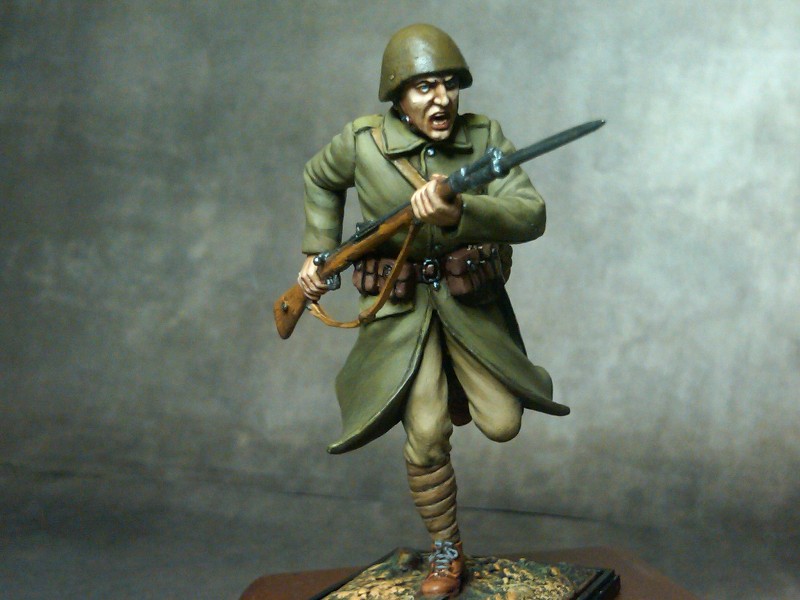


The Greco-Italian War, also known as the Italo-Greek War, was a conflict between Italy and Greece, which lasted from 28 October 1940 to 23 April 1941. The conflict marked the beginning of the Balkans campaign of World War II and the initial Greek counteroffensive, the first successful land campaign against the Axis powers in the war.
Admiral
PAVLOS KOUNTOURIOTIS (1855 - 1935) GREEK NAVY - Balkan
Wars 1912-13 code 5928
ΝΑΥΑΡΧΟΣ ΠΑΥΛΟΣ
ΚΟΥΝΤΟΥΡΙΩΤΗΣ - Βαλκανικοί
Πόλεμοι 1912 -
1913




Pavlos Kountouriotis (Greek: Παύλος Κουντουριώτης, 9 April 1855 – 22
August 1935) was a Greek
admiral and naval hero
during the Balkan Wars, regent,
and the
first and third
President of
the Second Hellenic Republic . In 1875, following his
family's long naval tradition, he joined the Royal Hellenic
Navy presumably at the rank of Ensign .
During the Greco-Turkish
War of 1897, serving as Lt.Commander he commanded the ship
Alfeios. His ship took part in at least two landings of
Greek troops on the island of Crete. In 1901, commanding the ship
Miaoulis, he was sent to Boston . This was reported as the
first transatlantic trip of a Greek war vessel. Kountouriotis
served as an aide-de-camp to King
Geórgios I from 1908 until 1911, receiving the rank of Captain
in 1909.
He was promoted to Rear Admiral in 1912, on the outbreak of the First Balkan War. During the Balkan Wars, with his flagship, the Georgios Averof, he led the Greek Navy to major victories against theTurkish fleet in December 1912 (Battle of Elli) and in January 1913 (Battle of Limnos), liberating most of the Aegean islands. His victories, due in large part to his daring but successful tactics, earned him the status of a national hero. He was promoted to Vice Admiral for "exceptional war service", the first Greek career officer since Constantine Kanaris to reach the rank. In March 1924, after King Geórgios II of the Hellenes was deposed, he was elected as the first President of the Second Hellenic Republic, but resigned the post in March, 1926. Pávlos Kountouriotis died in 1935.


GREEK
SOLDIER 1940 -
" Marching to the Front
" code 5940
Ελληνας
Στρατιώτης 1940 -
" Βαδίζοντας προς το Μέτωπο"



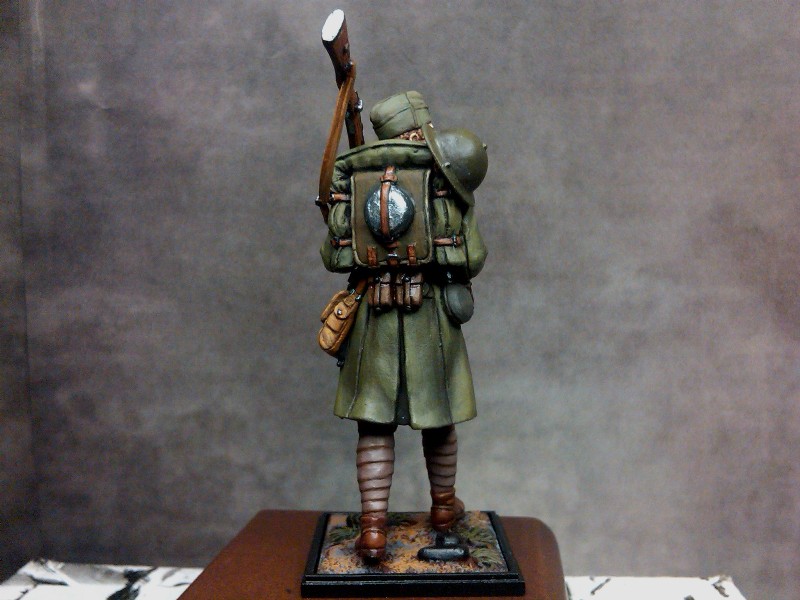
The soldier in the figure wears the Greek type M 1938 garrison
cup.
The helmet is the British Brondie helmet MK 1 . ( With the
figure is offered a second helmet , the Greek helmet M1938
)
He wears greatcoat and three twin bandoliers of brown leather,
Webbing Haversack M1932 of the Greek Army made from
hemp, which was an enhanced version of the French Mle 1892 Musette.
The colors were from beige to green khaki. During the 1940 War the
soldier could carry up to two haversacks. The buttons both
greatcoat and the sleeve were metal and painted khaki not to
shine.
He bears the Austrian Mannlicher - Schoenauer
M1903 infantry rifle, caliber 6.5 mm.
BASIL II
BULGAROKTONUS code
5328
ΒΑΣΙΛΕΙΟΣ
Β' ΒΟΥΛΓΑΡΟΚΤΟΝΟΣ
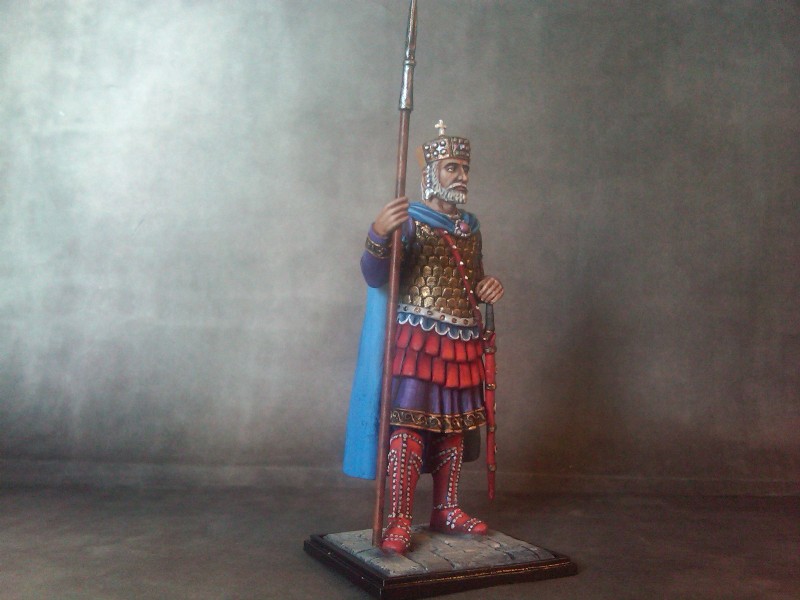


Basil II (Greek: Βασίλειος Β΄, Basileios II; 958 – 15 December 1025) was a Byzantine Emperor from the Macedonian dynasty who reigned from 10 January 976 to 15 December 1025. He was known in his time as Basil the Porphyrogenitus and Basil the Young to distinguish him from his supposed ancestor, Basil I the Macedonian.The early years of his long reign were dominated by civil war against powerful generals from the Anatolian aristocracy. Following their submission, Basil oversaw the stabilization and expansion of the eastern frontier of the Byzantine Empire, and above all, the final and complete subjugation of Bulgaria, the Empire's foremost European foe, after a prolonged struggle. For this he was nicknamed by later authors as "the Bulgar-slayer" (Greek: Βουλγαροκτόνος, Boulgaroktonos), by which he is popularly known. At his death, the Empire stretched from Southern Italy to the Caucasus and from the Danube to the borders of Palestine, its greatest territorial extent since the Muslim conquests four centuries earlier.
Despite near-constant warfare, Basil also showed himself a capable administrator, reducing the power of the great land-owning families who dominated the Empire's administration and military, while filling the Empire's treasury. Of far-reaching importance was Basil's decision to offer the hand of his sister Anna to Vladimir I of Kievin exchange for military support, which led to the Christianazation of the Kievan Rus' and the incorporation of later successor nations of Kievan Rus' within the Byzantine cultural and religious tradition.
EVZONE
CORPORAL TRUMPETER 1922
BATTLE OF DUMLUPINAR ASIA MINOR CAMPAIGN
code 5925
ΕΥΖΩΝΑΣ ΔΕΚΑΝΕΑΣ ΣΑΛΠΙΓΚΤΗΣ 1922 ΜΑΧΗ ΤΟΥΜΛΟΥ ΜΠΟΥΝΑΡ ΜΙΚΡΑΣΙΑΤΙΚΗ ΕΚΣΤΡΑΤΕΙΑ





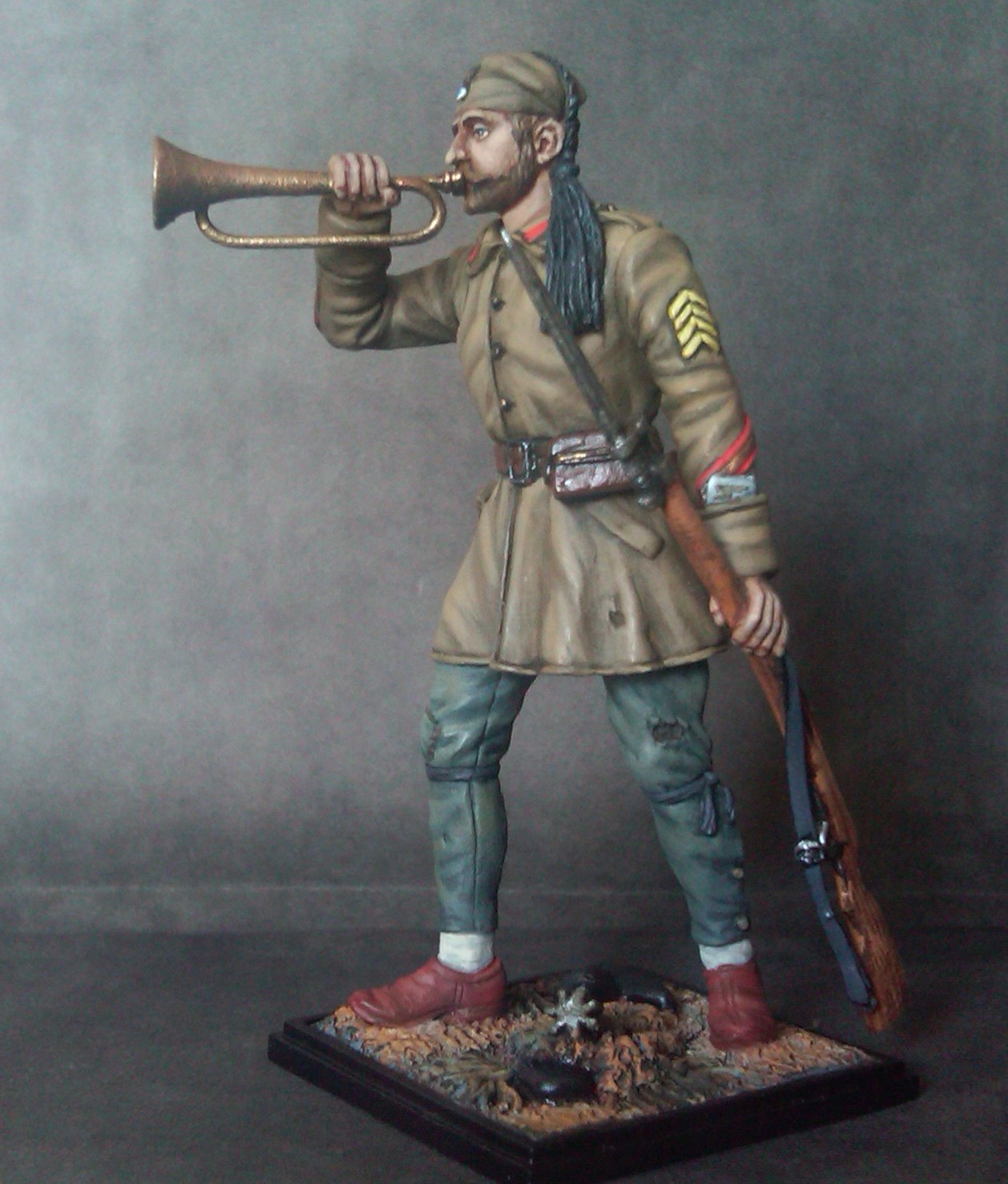

The bearded corporal Evzone trumpeter brings doulama M1915,
change to the M1908 (first time from khaki fabric with khaki
Fario). The characteristic red color of the infantry appears in the
insignia of grade on the sleeves and collar in the form of
patches.
On doulama's left sleeve is mounted discrete series of 4 inverted
chevrons, one for every 6 months military service in the front
line. The folding of the left sleeve distinguished documents and
orders. Instead Evzone socks he wears trousers (panties)
without cloth puttees and boots. He wears tsarouhia from
pig skin without the characteristic black pompoms. Kits M1908 is
Greek origin. Rifle is the Austrian Mannlicher Schonafer M1903 /
1914 rev 6.5 mm.
Ο γενειοφόρος δεκανέας ευζωνας φέρει τον ντουλαμά Μ1915,
τροποποίηση του αντίστοιχου Μ1908 ( από χακί ύφασμα για πρώτη
φορά με χακί φάριο). Το χαρακτηριστικό κόκκινο χρώμα του πεζικού
εμφανίζεται στα διακριτικά του βαθμού στα μανίκια και στο
περιλάιμιο με μορφή επιραμμάτων.
Στο αριστερό μανίκι του ντουλαμά είναι στερεωμένη διακριτή
σειρά 4 αντεστραμμένων σεβρον, ένα για κάθε εξάμηνο
πολεμικής υπηρεσίας στο μέτωπο.
Στην αναδίπλωση του αριστερού μανικιού διακρίνονται έγγραφα, διαταγές. Αντί για ευζωνικές κάλτσες φέρει πανταλόνι ( κυλότα) χωρίς γκαίτες και άρβυλα.
Φορά τσαρούχια , από δέρμα γουρουνιού χωρίς τις χαρακτηριστικές μαύρες φούντες. Οι εξαρτήσεις Μ1908 είναι ελληνικής προέλευσης. Το τυφέκιο είναι το αυστριακό Mannlicher Schonauer Μ1903/1914 των 6,5 χιλιοστών.
Eleftherios
VENIZELOS Prime Minister of
Greece 1864 -
1936 code 5927

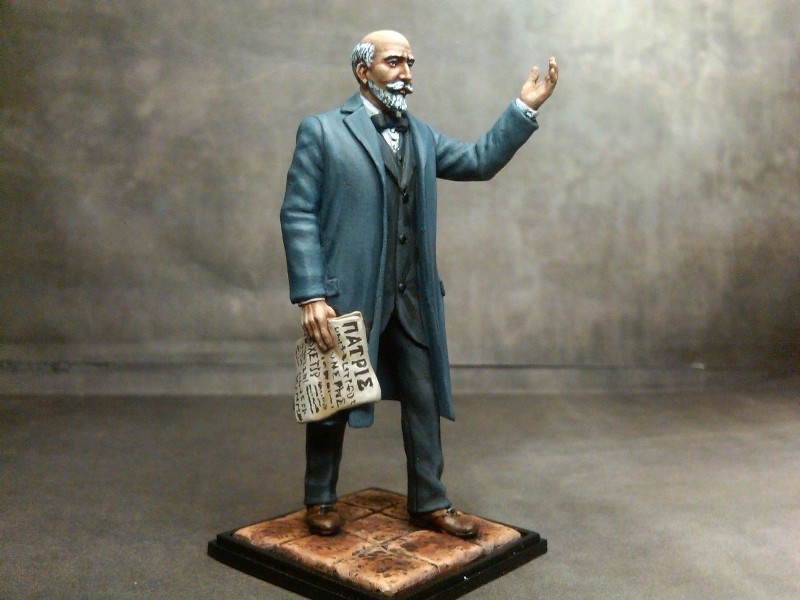



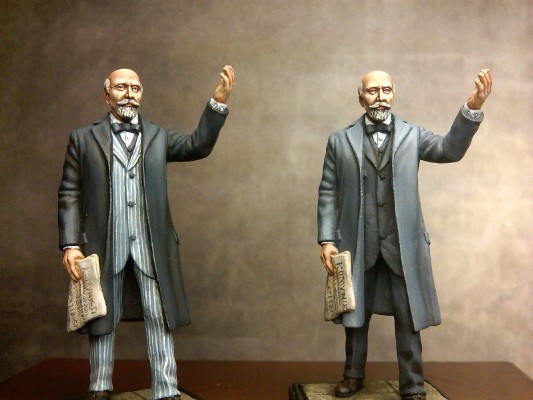

Eleftherios VENIZELOS Prime Minister of Greece 1864 - 1936 A second choice ( with hat)
Greek Cavalry
Division Lance Corporal Asia
Minor Campaign 1921 code 5931
Ελληνικό Ιππικό Υποδεκανέας Μικρά Ασία 1921
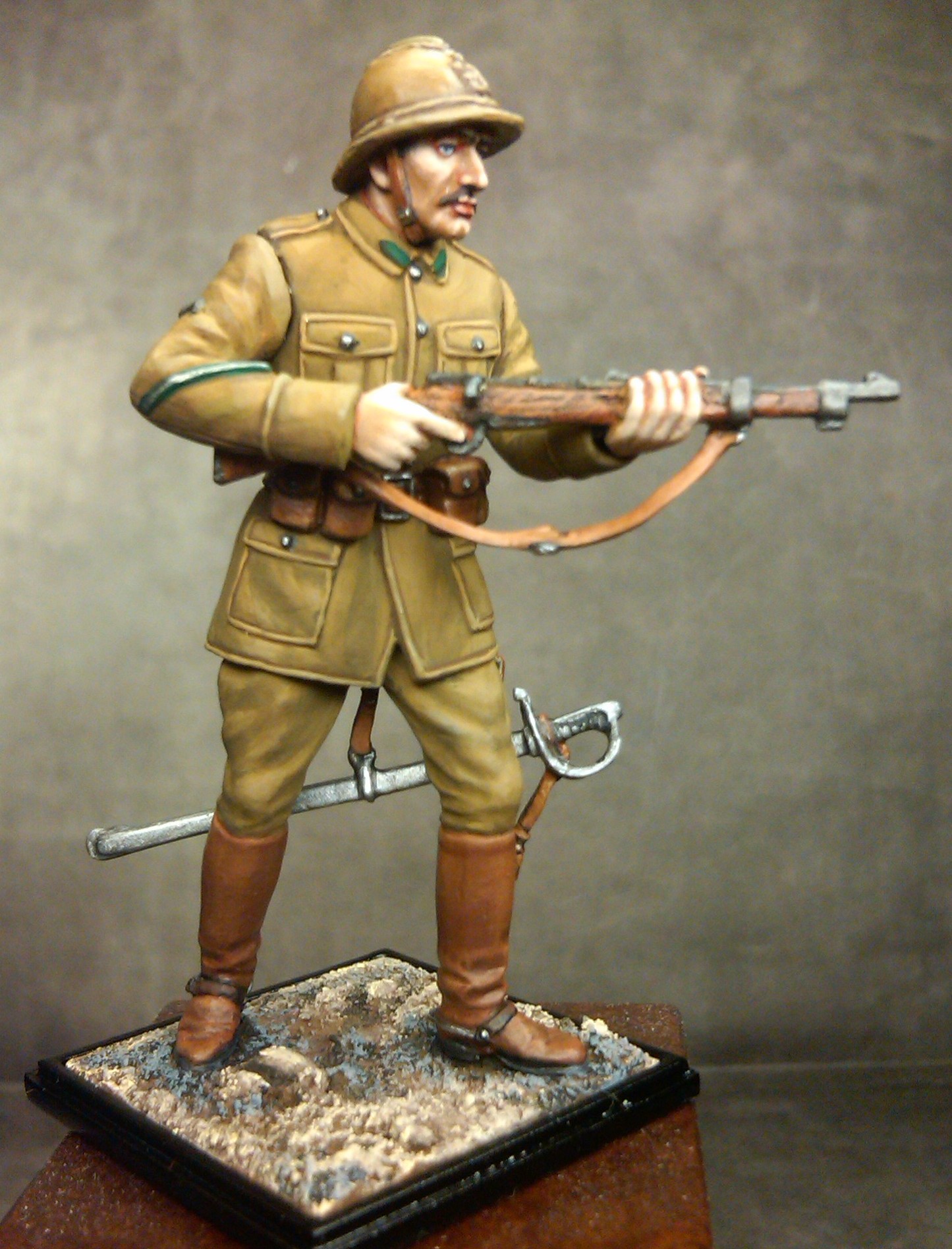

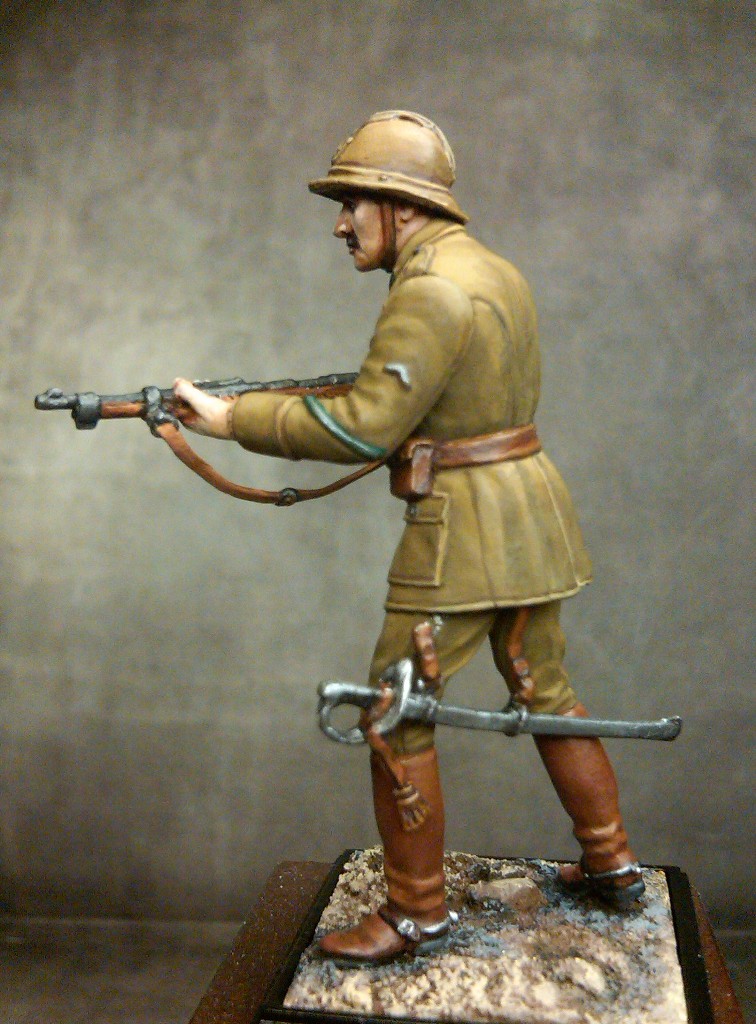

This soldier from the Cavalry Division wears the french Adrian M1915 steel helmet . The cavalry's dark green branch colour is shown on the tunic collar tabs and this was one of the branches of service distinguished by a white cap-badge crown and rank insignia. On his right upper sleeve a single black inverted chevron shows that he has been wounded once. On his left upper sleeve a white chevron means that he has completed a full six months' front line service. His woolen breeches are worn with riding boots. On his leather belt he has the ammunition pouches with central button down flap straps that were particular to mounted troops. He is armed with a Mannlicher Schonauer M1903/14 carbine and a cavalry sabre Μ1887.
Emperor ALEXIOS KOMNENOS Battle of Dyrrhachium 1081
ΑΛΕΞΙΟΣ ΚΟΜΝΗΝΟΣ Μάχη στο Δυρράχιο 1081




In the miniature Emperor Alexios Komninos wears cataphract or clibanarius outfit, with metal plates covering most of the body. Modular plates in the arms and the legs and chained armor the chest. Over klivanio bearing "epilorikio" to prevent overheating of the metal plates by sunlight. In the waist he has a mace = vardoukion (kefalothrafstis), double-edged sword and a shield tear drop or Kite style. On the shield the figure of the Archangel Michael is represented as an angelic warrior, fully armed with sword and shield . The imperial mantle of Alexios Komnenos is red with the non-crowned double headed eagle, emblem of the Komnenos dynasty. Later (1203) the Grand - Komninoi will adopt single-headed eagle as coat of arms.
Στη μινιατούρα ο αυτοκράτορας Αλέξιος Κομνηνός φέρει στολή κατάφρακτου ή κλιβανάριου, με μεταλλικές πλάκες που κάλυπταν το μεγαλύτερο μέρος του σώματος. Αρθρωτές θωρακίσεις στους βραχίονες και τις κνήμες και αλυσιδωτό θώρακα. Πάνω από το κλιβάνιο φέρει εφαπλωματοποιημένο « επιλωρίκιο» για να αποτρέπει την υπερθέρμανση των μεταλλικών πλακών από την ηλιακή ακτινοβολία. Στη μέση φέρει βαρδούκιον (κεφαλοθραύστης), σπάθα αμφίστομη και ασπίδα σχήματος «δάκρυ» (tear drop) ή Kite. Πάνω στην ασπίδα είναι ζωγραφισμένη η μορφή του Αρχάγγελου Μιχαήλ που φέρει ρομφαία. Η αυτοκρατορική χλαμύδα είναι ερυθρού χρώματος με το μη εστεμμένο Δικέφαλο Αετό, έμβλημα της δυναστείας των Κομνηνών. Αργότερα (1203) οι Μεγαλο - Κομνηνοί θα υιοθετήσουν ως οικόσημο τον Μονοκέφαλο Αετό.



GREEK EVZONES BALKAN WARS 1912 - 1913


GREEK ORTHODOX CLERGY



GREEK EVZONES BALKAN WARS 1912 - 1913 with Red Farion


GREEK ARMY ASIA MINOR CAMPAIGN 1919 - 1922






Diorama " Fighting for Freedom - Greek War of Independence 1821 "




Amother stunning work by Mr Roger Newsome
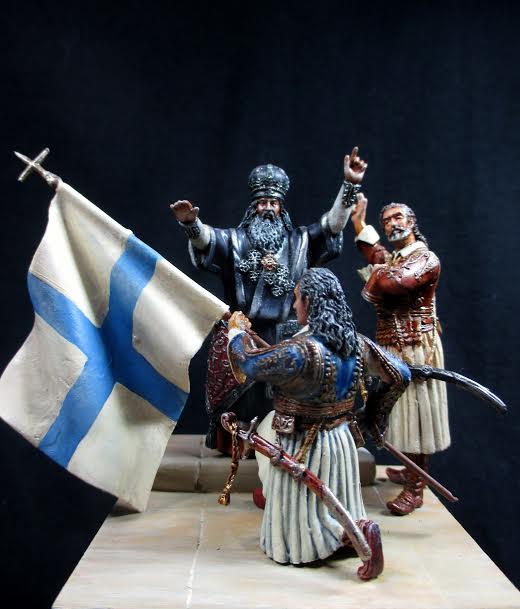



AGHIA LAVRA ,
March 25th , 1821 - Bishop Germanos of Patras blessing
the flag at Aghia Lavra monastery, launching the Greek War of
Independence.
A very nice work by a very good friend of Greek History and not only. Setting and painting by Mr. Roger Newsome
Theodoros
KOLOOKOTRONIS - Georgios KARAISKAKIS
, " Meeting of the two generals " Greek War of
Independence 1821

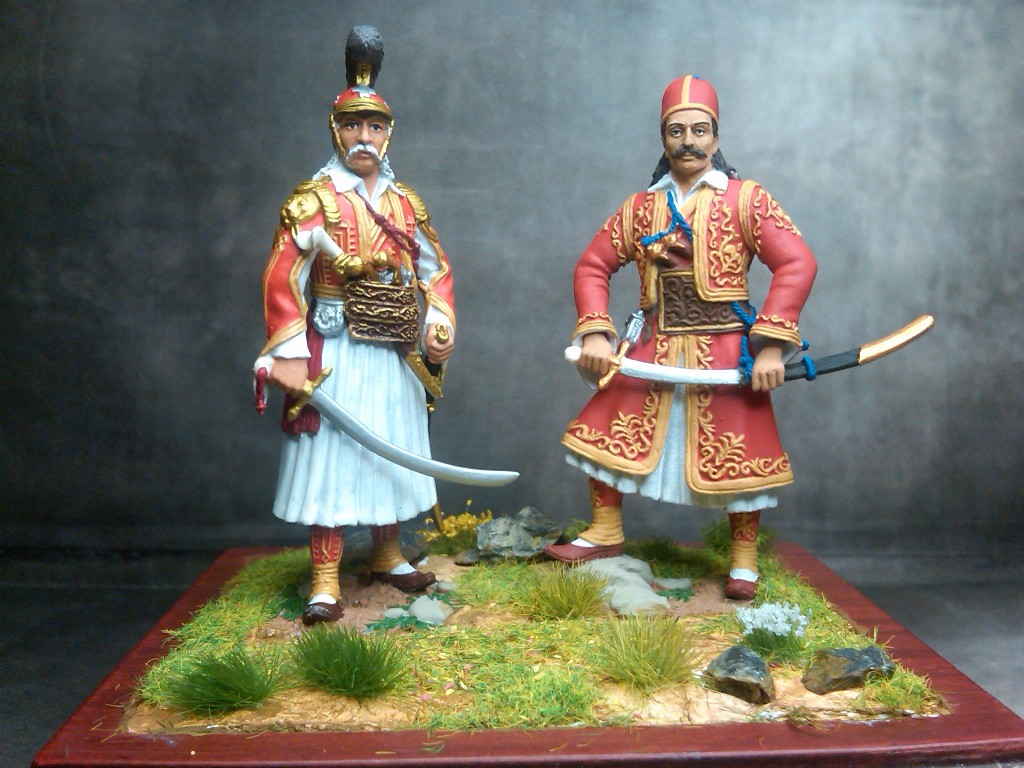

Lord George Gordon BYRON
1788 -1824




A Few Words on the Miniature: It's inspired by the familiar table, which conceals a little story. He portrays Byron wearing a red and gold velvet jacket and a gold red, blue green striped shawl around his head like a turban, a white shirt with a large black diamond on a neck in his neck, and in his hands holds a knot with a handle Purple color. When Lord Byron visited Ioannina in 1809 he bought the famous Souliot costume, with which he posed in 1813 for the well-known ¾ portrait created by the painter Thomas Phillips. The original painting was exhibited at the Royal Academy of London and is currently at the British Embassy in Athens. Phillips in 1835 and 1840 painted two copies of the painting. The first copy was donated in 1862 by the painter's son at the National Portrait Gallery in London, where he is still present.
The second copy, commissioned by Byron's publisher, John Murray, is at the publishing house on Albemarle Street in London.
What happened to the Suliot costume? Byron kept correspondence with Margaret Mercer Elphinstone, the daughter of Lord Keith, and in 1814 she donated to her the costume with the urge to wear it like fancy clothes. Over the years, the costume passed into the possession of the Lansdowne family and was discovered in 1962 by a scientist , Doris Langley Moore, who studied the life of Byron and went to Lansdowne's home in Bowood, Wiltshire, to collect objects for the creation of a Costume Museum in Bath. Today, Byron's costume is in Bowood.


"Sword and Lance
2017"
Darlington Military Modelling
Society
( painted figures and photos by
Roger Newsome)
Some fantastic dioramas created by our good friends Roger Scott and Geoff Barnes from distant but beautiful Australia

Gallipoli 1917 - Suvla
bay


Some photos of a diorama that Roger Scott and Geoff Barnes made for the Australian National Maritime Museum as part of their "Escape from Pompeii" exhibition which opened in March 2017. It shows the Roman naval port of Misenum from where Pliny the Elder, admiral of the Mediterranean fleet, planned a rescue mission using his triremes to doomed Pompeii and Herculaneum. Have a look at this website. it has a good article about building the misenum diorama.
http://www.insidehistory.com.au/2017/05/escape-from-pompeii-brought-to-life-in-a-diorama/

EVZONE GREEK PRESIDENTIAL GUARD
ΕΥΖΩΝΑΣ ΠΡΟΕΔΡΙΚΗ ΦΡΟΥΡΑ



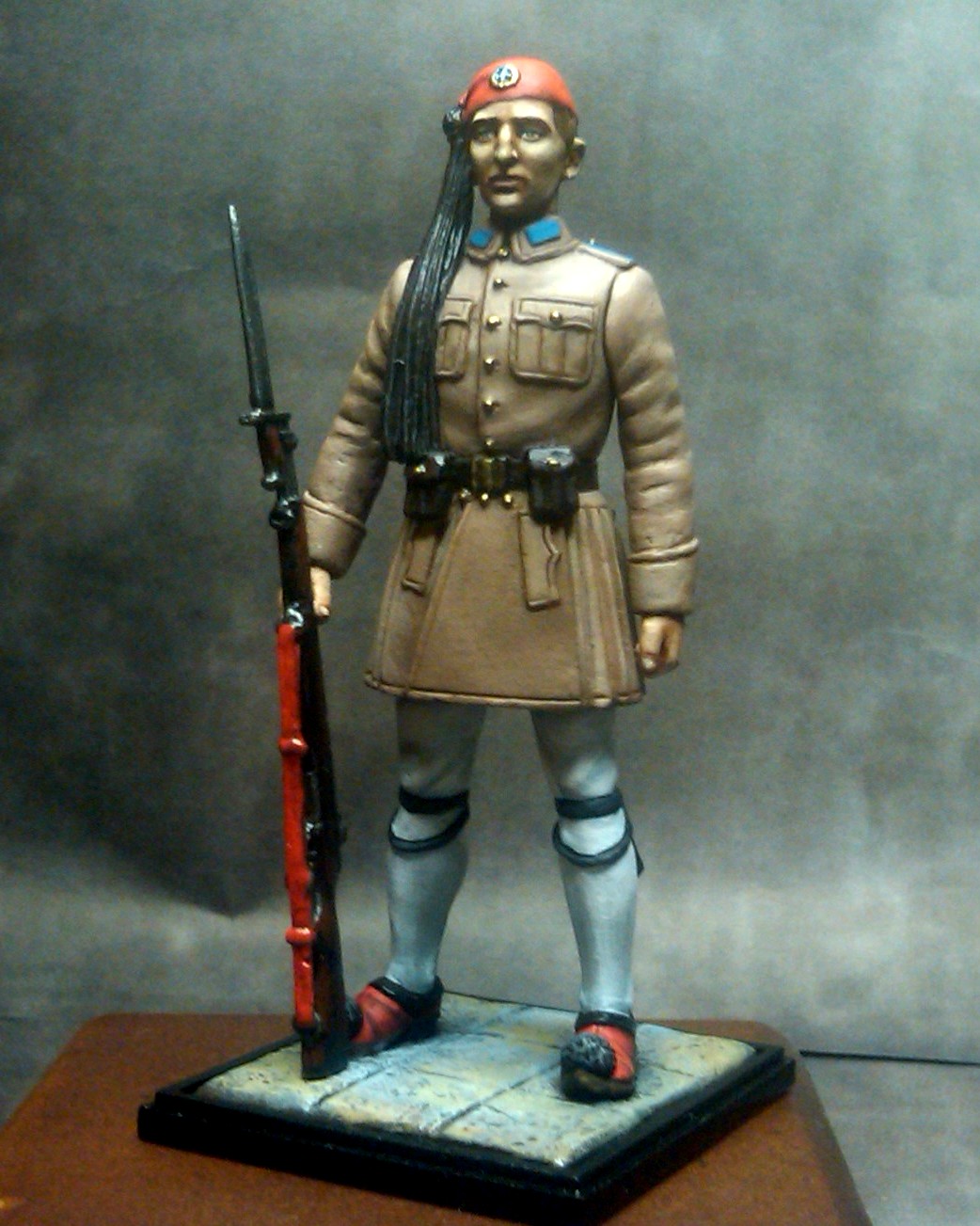
PRESIDENTIAL GUARD EVZONE in Winter Dress PRESIDENTIAL GUARD EVZONE in Summer Dress
The Evzones, or Evzoni (Greek: Εύζωνες, Εύζωνοι), is the name of several historical elite light infantry and mountain units of the Greek Army. Today, it refers to the members of the Presidential Guard (Greek: Προεδρική Φρουρά), an elite ceremonial unit that guards the Greek Tomb of the Unknown Soldier (Greek: Μνημείο του Άγνωστου Στρατιώτη), the Presidential Mansion (Greek : Προεδρικό Μέγαρο) and the gate of Evzones camp in Athens. The Evzones are also known, colloquially, as Tsoliades (Greek : Τσολιάδες; singular: Τσολιάς - Tsolias).
Though the Presidential Guard is a predominantly ceremonial unit, all Evzones are volunteers drawn from the Hellenic Army's Infantry, Artillery and Armoured Corps. Prospective Evzones are usually identified at the Army Recruit Training Centres during Basic Training; there is a minimum height requirement of 1.86 m (6' 1.2") to join.
The unit is famous around the world for its unique traditional
uniform, which has evolved from the clothes worn by the klephts
who fought the Ottoman occupation of Greece. The most visible item
of this uniform is the fustanella, a
kilt-like garment. Their proven valour and peculiar dress turned
them into a popular image for the Greek soldier, especially among
foreigners. VIDEO
"Meet the 'unflinching' Greek Presidential Guard"- BBC
News feature
The Official
Homepage Η επίσημη
ιστοσελίδα της Προεδρικής Φρουράς
EVZONES
, Greek Presidential
Guard , Balkan Wars
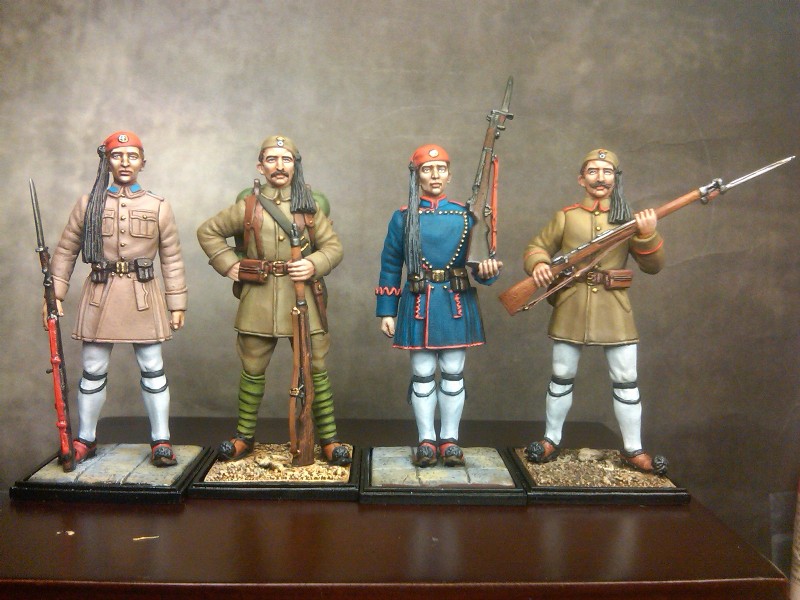

EVZONE
BALKAN WARS 1912 AND
EVZONE GRECO - TURKISH WAR
1921


EVZONE BALKAN WARS 1912 -
1913


GREEK ARMY 1940-1941 Kleisoura 10-1-1941
A very nice
vignette by John DINOS




Greek War Of Independence
1821
Vignettes and
dioramas from any period of Greek history . Ask for
more informations.


This is a constantly updated site with new miniatures and pictures. Keep an eye on it because always there is something interesting from Greek Heroes land.
We welcome inquiries and try to reply within 12h.
Your opinions and ideas are very
important to Greekheroes Models; so any suggestion is
welcomed.
If there is a subject or
personality related to Greek mythology, ancient or
contemporary history , you would like to be modeled and
you have ideas, suggestions, images , photographs and/or
information , please let us know sending an
e-mail.
None of the material on this site can be used for any purpose against any country, nation , ethnic group or minority.